Paul van Yperen's Blog, page 321
January 13, 2017
Teresa Ann Savoy (1955-2017)
On 9 January 2017, British actress Teresa Ann Savoy passed away. She lived in Italy, where she made most of her films, including the Tinto Brass films Salon Kitty (1976) and Caligula (1979). She was 61.
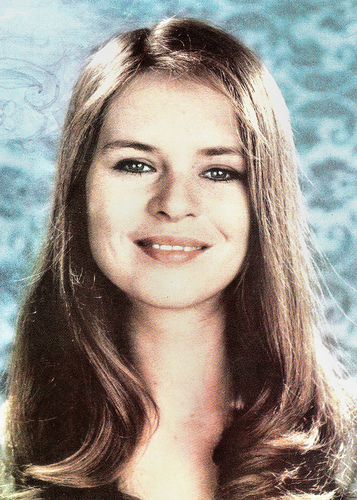
Romanian postcard by Casa Filmului Acin.
A SS spy that poses as a prostitute
Teresa Ann Savoy was born in 1955 in London, England. 'Terry' fled from home at 16. She lived in a hippie community in Sicily and soon came to the attention of the press.
Savoy was 18 years old when she appeared in the Italian adult magazine Playmen (October 1973). In 1974, her acting career began when film director Alberto Lattuada gave her her first role as a sexy teenager in Le farò da padre/I'll Take Her Like a Father (Alberto Lattuada, 1974).
Her next film was Vizi privati, pubbliche virtù/Private Vices, Public Pleasures (1975) directed by the Hungarian director Miklós Jancsó. The film told the story of the Crown Prince Rudolf, son of the Austrian-Hungarian Emperor Franz Joseph and his rebellion against his father. Teresa played the baroness Mary Vetsera, Rudolf's lover, but in Jancso's vision, she appears as a hermaphrodite.
In 1975 Savoy met Tinto Brass and they worked together in the successful but bizarre film Salon Kitty (1976) with Helmut Berger and Ingrid Thulin. In the film she played a young BDM girl (League of German Maidens, a female Nazi youth organization) who becomes a spy that poses as a prostitute for the SS Nazi paramilitary organization.
In 1976, Brass was involved in Caligola/Caligula, produced by Bob Guccione, the owner of Penthouse magazine. It tells about the rise and fall of the notorious Roman Emperor Caligula (Malcolm McDowell). Originally, Maria Schneider was cast as Drusilla, the beloved sister and lover of Caligula, but she walked out of the project and was replaced by Savoy.
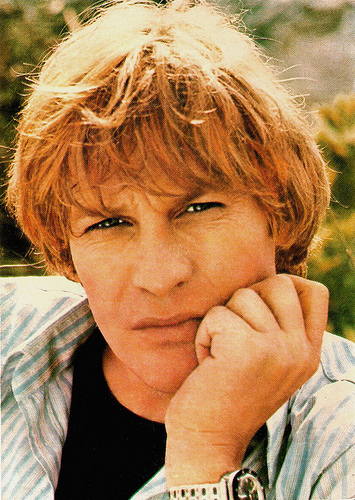
Helmut Berger . Romanian postcard by Casa Filmului Acin.
A terrorist in search of a traitor partner for killing
In 1981, Teresa Ann Savoy made a return to cinema with La disubbidienza/The disobedience (Aldo Lado, 1981), where she played Edith, an attractive Jewish governess. The film, based on a novel by Alberto Moravia, covered events under the reign of the Republic of Salò.
In the same year, she worked again with director Miklós Jancsó in the historical film A zsarnok szíve, avagy Boccaccio Magyarországon/The Tyrant's Heart (1981) in which she acted alongside Ninetto Davoli.
In the 1980s, she mainly played secondary roles such as in the TV mini-series La Certosa di Parma/The Charterhouse of Parma (Mauro Bolognini, 1982), featuring Marthe Keller. In 1984, Savoy was a terrorist in search of a traitor partner for killing in Il Ragazzo di Ebalus/The Boy from Ebalus (Giuseppe Schito, 1984) alongside Saverio Marconi.
Her most important secondary role in this period was that of Maria di Gallese, the first wife of the writer and poet Gabriele D'Annunzio (played by Robert Powell), in the film D'Annunzio (Sergio Nasca, 1987). She played another memorable part in the episode Addio Maschio Crudele/Goodbye Cruel Male from the TV series Quando Arriva il Giudice/When the judge arrives (Giulio Questi, 1986).
In 2000, she made her last film appearance in La Fabbrica del Vapore/The Steam Factory (Ettore Pasculli, 2000), the first Italian digital film. She received the title of Fellow of the Royal Society of Arts in 1989.
Teresa Ann Savoy died of cancer on 9 January 2017 in Milan, where she lived with her husband and two children.
Trailer for Salon Kitty (Tinto Brass, 1976). Source: ShortFormCinema (YouTube).
Trailer for Caligola/Caligula (Tinto Brass, 1976). Source: British Secret Agent 007 (YouTube).
Sources: Wikipedia and .

Romanian postcard by Casa Filmului Acin.
A SS spy that poses as a prostitute
Teresa Ann Savoy was born in 1955 in London, England. 'Terry' fled from home at 16. She lived in a hippie community in Sicily and soon came to the attention of the press.
Savoy was 18 years old when she appeared in the Italian adult magazine Playmen (October 1973). In 1974, her acting career began when film director Alberto Lattuada gave her her first role as a sexy teenager in Le farò da padre/I'll Take Her Like a Father (Alberto Lattuada, 1974).
Her next film was Vizi privati, pubbliche virtù/Private Vices, Public Pleasures (1975) directed by the Hungarian director Miklós Jancsó. The film told the story of the Crown Prince Rudolf, son of the Austrian-Hungarian Emperor Franz Joseph and his rebellion against his father. Teresa played the baroness Mary Vetsera, Rudolf's lover, but in Jancso's vision, she appears as a hermaphrodite.
In 1975 Savoy met Tinto Brass and they worked together in the successful but bizarre film Salon Kitty (1976) with Helmut Berger and Ingrid Thulin. In the film she played a young BDM girl (League of German Maidens, a female Nazi youth organization) who becomes a spy that poses as a prostitute for the SS Nazi paramilitary organization.
In 1976, Brass was involved in Caligola/Caligula, produced by Bob Guccione, the owner of Penthouse magazine. It tells about the rise and fall of the notorious Roman Emperor Caligula (Malcolm McDowell). Originally, Maria Schneider was cast as Drusilla, the beloved sister and lover of Caligula, but she walked out of the project and was replaced by Savoy.

Helmut Berger . Romanian postcard by Casa Filmului Acin.
A terrorist in search of a traitor partner for killing
In 1981, Teresa Ann Savoy made a return to cinema with La disubbidienza/The disobedience (Aldo Lado, 1981), where she played Edith, an attractive Jewish governess. The film, based on a novel by Alberto Moravia, covered events under the reign of the Republic of Salò.
In the same year, she worked again with director Miklós Jancsó in the historical film A zsarnok szíve, avagy Boccaccio Magyarországon/The Tyrant's Heart (1981) in which she acted alongside Ninetto Davoli.
In the 1980s, she mainly played secondary roles such as in the TV mini-series La Certosa di Parma/The Charterhouse of Parma (Mauro Bolognini, 1982), featuring Marthe Keller. In 1984, Savoy was a terrorist in search of a traitor partner for killing in Il Ragazzo di Ebalus/The Boy from Ebalus (Giuseppe Schito, 1984) alongside Saverio Marconi.
Her most important secondary role in this period was that of Maria di Gallese, the first wife of the writer and poet Gabriele D'Annunzio (played by Robert Powell), in the film D'Annunzio (Sergio Nasca, 1987). She played another memorable part in the episode Addio Maschio Crudele/Goodbye Cruel Male from the TV series Quando Arriva il Giudice/When the judge arrives (Giulio Questi, 1986).
In 2000, she made her last film appearance in La Fabbrica del Vapore/The Steam Factory (Ettore Pasculli, 2000), the first Italian digital film. She received the title of Fellow of the Royal Society of Arts in 1989.
Teresa Ann Savoy died of cancer on 9 January 2017 in Milan, where she lived with her husband and two children.
Trailer for Salon Kitty (Tinto Brass, 1976). Source: ShortFormCinema (YouTube).
Trailer for Caligola/Caligula (Tinto Brass, 1976). Source: British Secret Agent 007 (YouTube).
Sources: Wikipedia and .
Published on January 13, 2017 15:16
January 12, 2017
Jutta Freybe
German stage and film actress Jutta Freybe (1917–1971) was the attractive blond leading lady in ten films during the Nazi era.
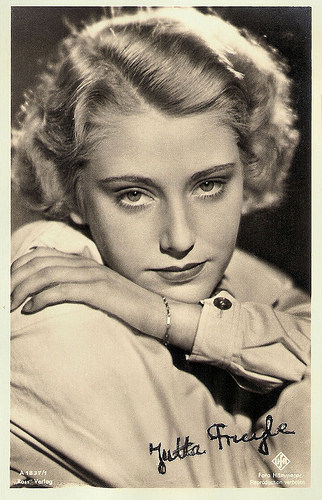
German postcard by Ross Verlag, no. A 1837/1, 1937-1938. Photo: Hammerer / Ufa.
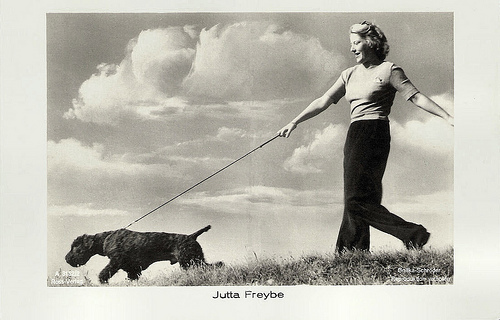
German postcard by Ross Verlag, no. A 3152/2, 1941-1944. Photo: Gnilka-Schröder.
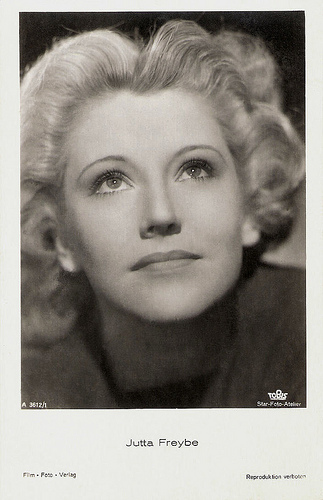
German postcard by Film-Foto-Verlag, no. A 3612/1, 1941-1944. Photo: Tobis / Star-Foto-Atelier.
Love Can Lie
Jutta Freybe was born in Berlin in 1917. She was the daughter of Major Paul Freybe and his wife, Paula Vick, the daughter of a merchant. Her older sisters were the writers Johanna Sibelius and Martha Albrand (a.k.a. Katrin Holland).
After a theatrical training by director Hans Schlenk, Jutta was engaged at the Landestheater (State Theatre) and performed in various small roles.
Her film career started with a part in the short film Die Wunderschießbude/The Miracle Shooter (Hans Fritz Köllner, 1934), produced by the Ufa. In 1937 she co-starred in the romance Liebe kann lügen/Love Can Lie (Heinz Helbig, 1937) with Karl Ludwig Diehl and Dorothea Wieck . It was her breakthrough and more leading film roles soon followed.
Willy Fritsch was her co-star in Gewitterflug zu Claudia/A Thunderstorm flight to Claudia (Erich Waschneck, 1937). She starred opposite Paul Hartmann in Pour le Mérite (Karl Ritter, 1938), produced by the Ufa. This Nazi propaganda film, which chronicles the rise of the German Luftwaffe (Air Force) from World War I until Adolf Hitler took power in 1933, was forbidden after the Second World War.
Other films were Was tun, Sybille?/What to do, Sybille? (Peter Paul Brauer, 1938), the drama Zwischen den Eltern/Between the Parents (Hans Hinrich, 1938) again opposite Willy Fritsch , and the crime drama Sensationsprozess Casilla/Sensation Process Casilla (Eduard von Borsody, 1939), starring Heinrich George .
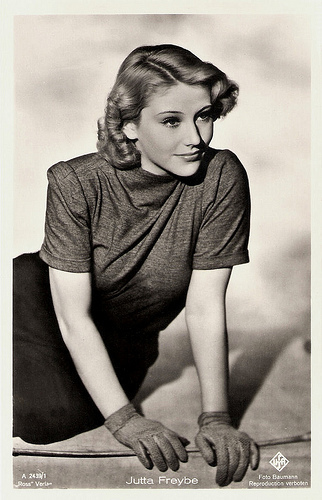
German postcard by Ross Verlag, no. A 2439/1, 1939-1940. Photo: Baumann / Ufa.
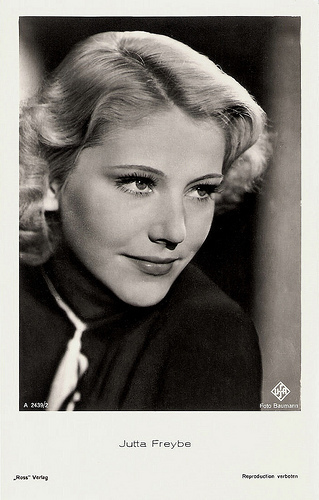
German postcard by Ross Verlag, no. A 2439/2, 1939-1940. Photo: Baumann / Ufa.
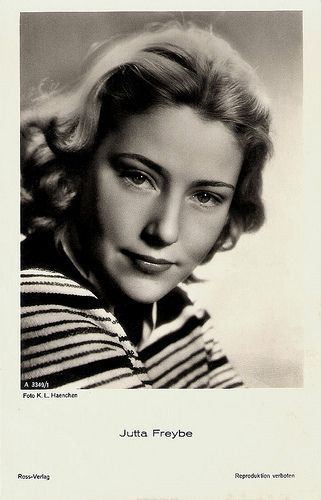
German postcard by Ross Verlag, no. A 3349/1, 1941-1944. Photo: K.L. Haenchen.
The Golden Spider
In 1939, Jutta Freybe married star actor Albert Matterstock , but the marriage ended in a divorce because of his morphine addiction.
She appeared that year in two more films, Silvesternacht am Alexanderplatz/New Year's Eve at the Alexanderplatz (Richard Schneider-Edenkoben, 1939) with Hannes Stelzer , and the crime film Alarm auf Station III/Alarm at Station III (Philipp Lothar Mayring, 1939) as the bride of Gustav Fröhlich .
During wartime she only took part in one film. Her final role was a doctor in the spy thriller Die goldene Spinne/The Golden Spider (Erich Engels, 1943), at the side of Kirsten Heiberg and Harald Paulsen .
Lars Bellman at IMDb : “A pair of Soviet Spies use seduction and blackmail to discover the secrets of a new German tank. This is another war propaganda movie, with strong anti-Soviet tendencies. Scandinavian actress Kirsten Heiberg is a pleasure to look at in this otherwise below average movie.” After the war, this film was also forbidden by the allied forces.
After this film the then 26-years-old actress retired from the film business and little was heard from her since. Jutta Freybe died in Büsum, West Germany, in 1971. She was 53 and largely forgotten.
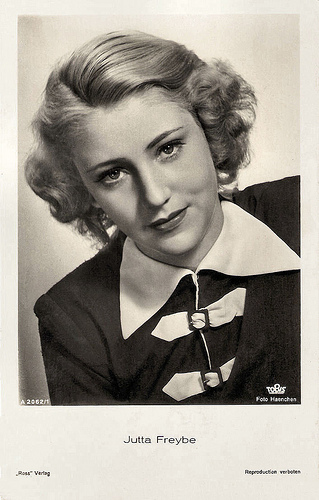
German postcard by Ross Verlag, no. A 2062/1, 1939-1940. Photo: Haenchen / Tobis.

German postcard by Ross Verlag, no. A 3152/1, 1941-1944. Photo: Haenchen.
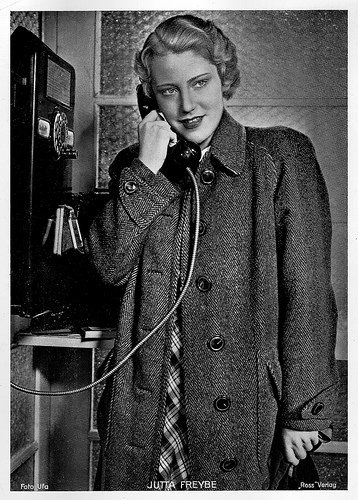
Big German card by Film-Foto-Verlag. Photo: Ufa.
Sources: Stephanie d’Heil (Steffi-line – German), Wikipedia (German and English) and .

German postcard by Ross Verlag, no. A 1837/1, 1937-1938. Photo: Hammerer / Ufa.

German postcard by Ross Verlag, no. A 3152/2, 1941-1944. Photo: Gnilka-Schröder.

German postcard by Film-Foto-Verlag, no. A 3612/1, 1941-1944. Photo: Tobis / Star-Foto-Atelier.
Love Can Lie
Jutta Freybe was born in Berlin in 1917. She was the daughter of Major Paul Freybe and his wife, Paula Vick, the daughter of a merchant. Her older sisters were the writers Johanna Sibelius and Martha Albrand (a.k.a. Katrin Holland).
After a theatrical training by director Hans Schlenk, Jutta was engaged at the Landestheater (State Theatre) and performed in various small roles.
Her film career started with a part in the short film Die Wunderschießbude/The Miracle Shooter (Hans Fritz Köllner, 1934), produced by the Ufa. In 1937 she co-starred in the romance Liebe kann lügen/Love Can Lie (Heinz Helbig, 1937) with Karl Ludwig Diehl and Dorothea Wieck . It was her breakthrough and more leading film roles soon followed.
Willy Fritsch was her co-star in Gewitterflug zu Claudia/A Thunderstorm flight to Claudia (Erich Waschneck, 1937). She starred opposite Paul Hartmann in Pour le Mérite (Karl Ritter, 1938), produced by the Ufa. This Nazi propaganda film, which chronicles the rise of the German Luftwaffe (Air Force) from World War I until Adolf Hitler took power in 1933, was forbidden after the Second World War.
Other films were Was tun, Sybille?/What to do, Sybille? (Peter Paul Brauer, 1938), the drama Zwischen den Eltern/Between the Parents (Hans Hinrich, 1938) again opposite Willy Fritsch , and the crime drama Sensationsprozess Casilla/Sensation Process Casilla (Eduard von Borsody, 1939), starring Heinrich George .

German postcard by Ross Verlag, no. A 2439/1, 1939-1940. Photo: Baumann / Ufa.

German postcard by Ross Verlag, no. A 2439/2, 1939-1940. Photo: Baumann / Ufa.

German postcard by Ross Verlag, no. A 3349/1, 1941-1944. Photo: K.L. Haenchen.
The Golden Spider
In 1939, Jutta Freybe married star actor Albert Matterstock , but the marriage ended in a divorce because of his morphine addiction.
She appeared that year in two more films, Silvesternacht am Alexanderplatz/New Year's Eve at the Alexanderplatz (Richard Schneider-Edenkoben, 1939) with Hannes Stelzer , and the crime film Alarm auf Station III/Alarm at Station III (Philipp Lothar Mayring, 1939) as the bride of Gustav Fröhlich .
During wartime she only took part in one film. Her final role was a doctor in the spy thriller Die goldene Spinne/The Golden Spider (Erich Engels, 1943), at the side of Kirsten Heiberg and Harald Paulsen .
Lars Bellman at IMDb : “A pair of Soviet Spies use seduction and blackmail to discover the secrets of a new German tank. This is another war propaganda movie, with strong anti-Soviet tendencies. Scandinavian actress Kirsten Heiberg is a pleasure to look at in this otherwise below average movie.” After the war, this film was also forbidden by the allied forces.
After this film the then 26-years-old actress retired from the film business and little was heard from her since. Jutta Freybe died in Büsum, West Germany, in 1971. She was 53 and largely forgotten.

German postcard by Ross Verlag, no. A 2062/1, 1939-1940. Photo: Haenchen / Tobis.

German postcard by Ross Verlag, no. A 3152/1, 1941-1944. Photo: Haenchen.

Big German card by Film-Foto-Verlag. Photo: Ufa.
Sources: Stephanie d’Heil (Steffi-line – German), Wikipedia (German and English) and .
Published on January 12, 2017 22:00
January 11, 2017
Sabu
British Indian actor Sabu (1924-1963) became an instant star with the release of the British film Elephant Boy (1937). He also starred as Abu, the thief in the Arabian fantasy-adventure The Thief of Bagdad (1940) and as Mowgli in Jungle Book (1942). Sabu had 'a smile as broad as the Ganges and charm enough to lure the stripes off a tiger'. His succession of tropical Technicolor treats delighted audiences before and during WW II. Although restricted to stereotypical roles, he was the first Indian actor to make it big in Hollywood.
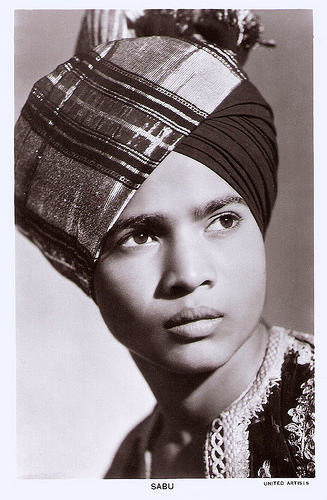
British postcard in the Picturegoer series, London, no. 1155. Photo: United Artists.
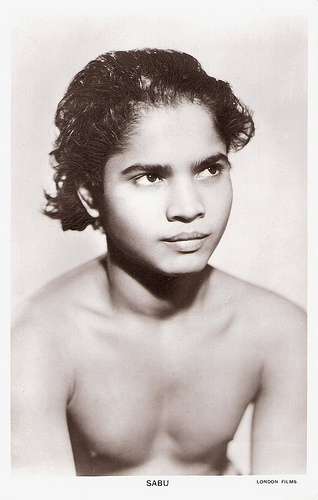
British postcard in the Picturegoer series, London, no. 1155b. Photo: London Films.
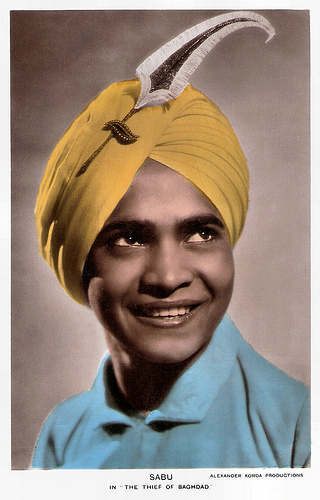
British postcard in the Colourgraph Series, London, no. C. 338. Photo: Alexander Korda Productions. Publicity still for The Thief of Baghdad (Ludwig Berger, Michael Powell, Tim Whelan, 1940).
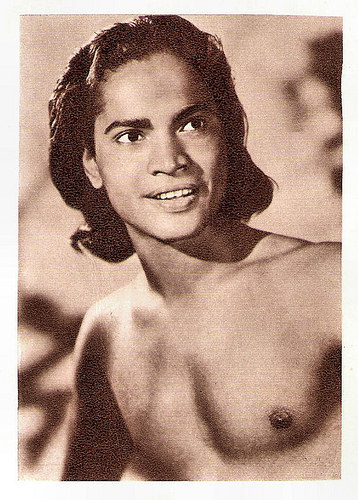
Vintage collectors card. Photo: publicity still for Jungle Book (Zoltan Korda, 1942) with Sabu as Mowgli.
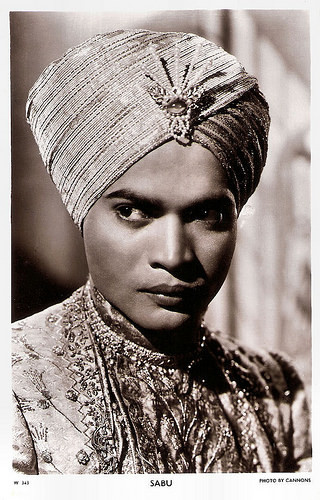
British postcard in the Picturegoer series, London, no. W 343. Photo: Cannons. Publicity still for Black Narcissus (Michael Powell, Emeric Pressburger, 1947).
A smile as broad as the Ganges
Sabu was born in the jungles of Karapur, in the little town of Mysore in southern British India, in 1924. Most reference books list his full name as Sabu Dastigir, but research by journalist Philip Leibfried learned that this was his brother's first name, and that Sabu's full name was, in fact, Selar Shaik Sabu. Sabu's son Paul later confirmed this. Sabu's mother died when he was still very young and he was raised by his father, a Mahout (elephant driver) in service for the Maharajah of Mysore.
When his father also passed away in 1931, the six-year-old Sabu was taken into the service of the Maharajah of Mysore, first as a stable boy, then as a mahout in his own right. It was when riding one of his beloved elephants that director Robert Flaherty first saw him when looking for someone to play Toomai of the Elephants in his upcoming feature Elephant Boy (Robert J. Flaherty, Zoltán Korda, 1937), based on a story from The Jungle Books by Rudyard Kipling.
Filming began in the spring of 1935, but bad weather held up any real work until later that year. The film had a troubled two-year gestation, with Flaherty being replaced by producer Alexander Korda's brother, Zoltán Korda, mid-production and Sabu shipped over to England for six weeks of studio scenes. Alexander Korda was quite taken aback by Sabu's earnest looks, engaging naturalness and adaptability to wild animals and their natural habitat, and he placed the boy under an exclusive contract.
Sabu and his older brother (as a guardian) became subsequent wards of the British government. They were given schooling in the process and Sabu quickly learned the English language. Philip Leibfreid wrote in a 1989 article in Films in Review : "With a smile as broad as the Ganges and charm enough to lure the stripes off a tiger, the young Indian also added the authenticity needed in the lead role." The film was the official British entry at the Venice Film Festival that year where it won the award for best direction.
Elephant Boy was an unqualified hit and the young actor was promptly placed in The Drum (Zoltán Korda, 1938). He was surrounded by a cast that included Raymond Massey and Valerie Hobson . Philip Leibfried: "Filmed in the hills of South Wales, The Drum is the story of the friendship of an English drummer boy and an Indian prince whose father is assassinated by the boy's uncle, who plans a massacre of the British troops at a banquet. The prince discovers the plot and alerts the British by signalling his friend on a large drum. Shot in Technicolor and directed by Zoltán Korda, it holds up very well today."
Michael Brooke at BFI Screenonline adds: "Sabu's winning performance as heroic young Prince Azim showed that he had real range as an actor". Hollywood started taking a keen look at this refreshingly new talent when he first arrived in the US for a publicity tour. Again, his second film was given rave reviews, proving that Sabu would not be just a one-hit wonder. His third film for Alexander Korda, the Arabian fantasy-adventure The Thief of Baghdad (Ludwig Berger, Michael Powell, 1940) with Sabu as Abu the Thief, is even a true classic."
Philip Leibfried: "The Thief of Bagdad is one of the most wonderfully realized fantasy films ever produced. It contains all the elements of which dreams are made: a beautiful princess (June Duprez), a malevolent vizier (played to the hilt by Conrad Veidt ), a genie in a bottle (superbly portrayed by black actor Rex Ingram), a fabulous jewel, a hidden temple, a giant spider, and a flying carpet - all presented in vivid Technicolor by design experts William Cameron Menzies (who had worked on the original film) and Vincent Korda. (...) When finally released on Christmas Day, 1940, The Thief of Bagdad was deservedly a smash hit, as well as winning Oscars for color cinematography, color art direction, and visual and sound special effects."
Sabu's name began stirring international ears. His last pairing with Korda was the adaptation of Rudyard Kipling's classic tale Jungle Book (Zoltán Korda, 1942) playing Mowgli. Leibfried writes: "Sabu was a natural for Mowgli, the feral child raised by a wolf pack. Animal footage was cleverly integrated with that of the humans so that the beasts seemed directly involved with the humans; only the snakes were models." Following this triumph, Sabu officially became the commodity of Universal Pictures and he settled in Hollywood. In 1944, almost 20 years old, he became a citizen of the USA.
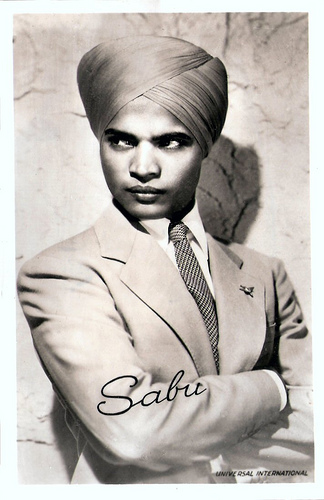
Dutch postcard. Photo: Universal International.
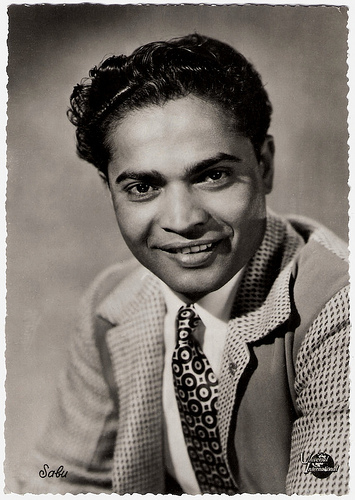
Belgian photo card by Fotoprim, Brussels, no. A 12, presented by De Beukelaer's factories for biscuits and chocolates, Antwerp. Photo: Universal Film.
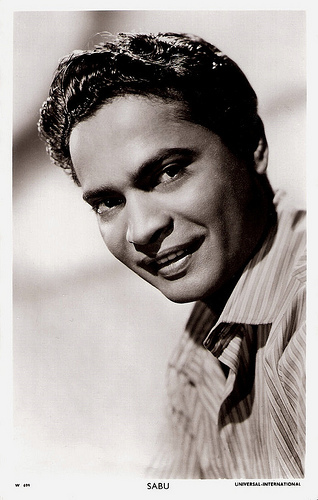
British postcard in the Picturegoer series, London, no. W 699. Photo: Universal-International.
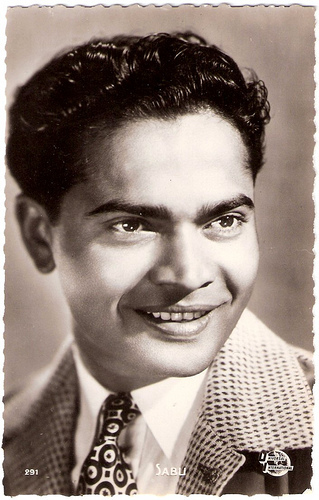
French postcard by Edition P.I., Paris, no. 291. Photo: Universal International.
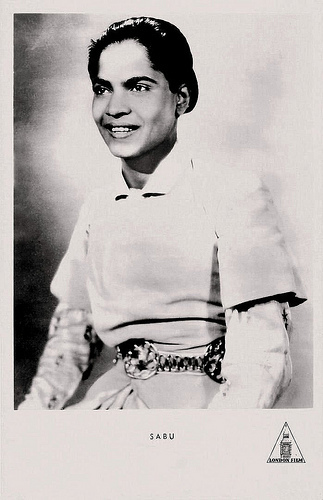
German postcard by Kunst und Bild, Berlin, no. A 265. Photo: London Films.
Colourful, Mindless Entertainment
After becoming an American citizen, Sabu joined the US Army Air Force as a tail gunner. He flew several dozens of missions over the Pacific and was awarded the distinguished Flying Cross for his valour and bravery.
Unfortunately, Hollywood developed an assembly-line of empty-minded features for Sabu that hardly compared to his English quality pictures under Korda. He appeared in four films in support of 'The Queen of Technicolor', Maria Montez . At IMDb , Gary Brumburgh writes: "His vehicles Arabian Nights (John Rawlins, 1942), White Savage (Arthur Lubin, 1943), and Cobra Woman (Robert Siodmak, 1944) were, for the most part, drivel but fit the bill as colorful, mindless entertainment."
Sabu went back to England in 1946, starring in the crime drama The End of the River (Derek N. Twist, 1947) and appearing fourth-billed as the son of a native general in Black Narcissus (Michael Powell, Emeric Pressburger, 1947). His role in the exotic Technicolor extravaganza was not major but still important. Gary Brumburgh: "Daring in subject matter, the film had Deborah Kerr heading up a group of Anglican nuns who battle crude traditions, unexpected passions and stark raving madness while setting up a Himalayan order." Sabu appears about midway, wearing the scent that gives the story its title. He becomes the object of desire of a young pupil ( Jean Simmons ) and runs off with her.
While filming Song of India (Albert S. Rogell, 1949) in Hollywood, Sabu met and married actress Marilyn Cooper who temporarily filled in for an ailing Gail Russell on the set. The couple went on to have two children. Around 1950 Sabu had begun a successful contracting and real estate business which occupied most of his time when he was not acting.
Through most of the 1950s Sabu played in largely unsuccessful European films. In 1952, he appeared with an elephant act in Harringay Circus. Sabu was sued by an infant girl (born in 1948), through her mother, an unnamed unmarried English actress, who claimed to have had an affair with Sabu and that he was the infant's father. The suit was tried by a jury which returned a nine to three verdict in favour of Sabu.
His last two pictures were supporting roles in Rampage (Phil Karlson, 1963), which starred Robert Mitchum, and A Tiger Walks (Norman Tokar, 1964), according to Gary Brumburgh "a routine Disney picture which was released posthumously".
In 1963 Sabu suddenly died of a heart attack in Chatsworth, California. He was only 39. Sabu was survived by his wife Marilyn, his son Paul Sabu, who established the rock band Sabu in the 1980s, an his daughter Jasmine Sabu, who was an animal trainer on various films. Yasmine died in 2001.
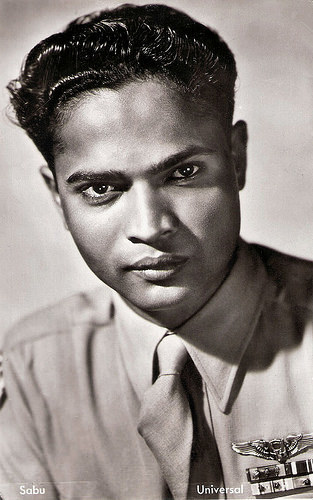
Dutch photo card by DRC, no. 17. Photo: MPEA.
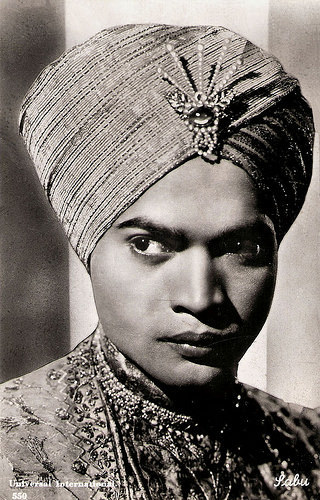
Vintage postcard, no. 550. Photo: Universal International. Publicity still for Black Narcissus (Michael Powell, Emeric Pressburger, 1947).
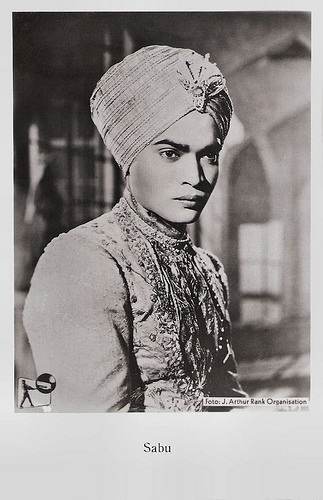
Dutch postcard. Photo: J. Arthur Rank Organisation. Publicity still for Black Narcissus (Michael Powell, Emeric Pressburger, 1947).
Trailer for The Thief of Bagdad (1940). Source: Flame Flamable (YouTube).
Trailer for Jungle Book (1942). Source: Adlerangriffe (YouTube).
Trailer for Black Narcissus (1947). Source: ryy79 (YouTube).
Sources: (IMDb), Philip Leibfried (Films in Review), Michael Brooke (BFI Screenonline), Wikipedia, and .

British postcard in the Picturegoer series, London, no. 1155. Photo: United Artists.

British postcard in the Picturegoer series, London, no. 1155b. Photo: London Films.

British postcard in the Colourgraph Series, London, no. C. 338. Photo: Alexander Korda Productions. Publicity still for The Thief of Baghdad (Ludwig Berger, Michael Powell, Tim Whelan, 1940).

Vintage collectors card. Photo: publicity still for Jungle Book (Zoltan Korda, 1942) with Sabu as Mowgli.

British postcard in the Picturegoer series, London, no. W 343. Photo: Cannons. Publicity still for Black Narcissus (Michael Powell, Emeric Pressburger, 1947).
A smile as broad as the Ganges
Sabu was born in the jungles of Karapur, in the little town of Mysore in southern British India, in 1924. Most reference books list his full name as Sabu Dastigir, but research by journalist Philip Leibfried learned that this was his brother's first name, and that Sabu's full name was, in fact, Selar Shaik Sabu. Sabu's son Paul later confirmed this. Sabu's mother died when he was still very young and he was raised by his father, a Mahout (elephant driver) in service for the Maharajah of Mysore.
When his father also passed away in 1931, the six-year-old Sabu was taken into the service of the Maharajah of Mysore, first as a stable boy, then as a mahout in his own right. It was when riding one of his beloved elephants that director Robert Flaherty first saw him when looking for someone to play Toomai of the Elephants in his upcoming feature Elephant Boy (Robert J. Flaherty, Zoltán Korda, 1937), based on a story from The Jungle Books by Rudyard Kipling.
Filming began in the spring of 1935, but bad weather held up any real work until later that year. The film had a troubled two-year gestation, with Flaherty being replaced by producer Alexander Korda's brother, Zoltán Korda, mid-production and Sabu shipped over to England for six weeks of studio scenes. Alexander Korda was quite taken aback by Sabu's earnest looks, engaging naturalness and adaptability to wild animals and their natural habitat, and he placed the boy under an exclusive contract.
Sabu and his older brother (as a guardian) became subsequent wards of the British government. They were given schooling in the process and Sabu quickly learned the English language. Philip Leibfreid wrote in a 1989 article in Films in Review : "With a smile as broad as the Ganges and charm enough to lure the stripes off a tiger, the young Indian also added the authenticity needed in the lead role." The film was the official British entry at the Venice Film Festival that year where it won the award for best direction.
Elephant Boy was an unqualified hit and the young actor was promptly placed in The Drum (Zoltán Korda, 1938). He was surrounded by a cast that included Raymond Massey and Valerie Hobson . Philip Leibfried: "Filmed in the hills of South Wales, The Drum is the story of the friendship of an English drummer boy and an Indian prince whose father is assassinated by the boy's uncle, who plans a massacre of the British troops at a banquet. The prince discovers the plot and alerts the British by signalling his friend on a large drum. Shot in Technicolor and directed by Zoltán Korda, it holds up very well today."
Michael Brooke at BFI Screenonline adds: "Sabu's winning performance as heroic young Prince Azim showed that he had real range as an actor". Hollywood started taking a keen look at this refreshingly new talent when he first arrived in the US for a publicity tour. Again, his second film was given rave reviews, proving that Sabu would not be just a one-hit wonder. His third film for Alexander Korda, the Arabian fantasy-adventure The Thief of Baghdad (Ludwig Berger, Michael Powell, 1940) with Sabu as Abu the Thief, is even a true classic."
Philip Leibfried: "The Thief of Bagdad is one of the most wonderfully realized fantasy films ever produced. It contains all the elements of which dreams are made: a beautiful princess (June Duprez), a malevolent vizier (played to the hilt by Conrad Veidt ), a genie in a bottle (superbly portrayed by black actor Rex Ingram), a fabulous jewel, a hidden temple, a giant spider, and a flying carpet - all presented in vivid Technicolor by design experts William Cameron Menzies (who had worked on the original film) and Vincent Korda. (...) When finally released on Christmas Day, 1940, The Thief of Bagdad was deservedly a smash hit, as well as winning Oscars for color cinematography, color art direction, and visual and sound special effects."
Sabu's name began stirring international ears. His last pairing with Korda was the adaptation of Rudyard Kipling's classic tale Jungle Book (Zoltán Korda, 1942) playing Mowgli. Leibfried writes: "Sabu was a natural for Mowgli, the feral child raised by a wolf pack. Animal footage was cleverly integrated with that of the humans so that the beasts seemed directly involved with the humans; only the snakes were models." Following this triumph, Sabu officially became the commodity of Universal Pictures and he settled in Hollywood. In 1944, almost 20 years old, he became a citizen of the USA.

Dutch postcard. Photo: Universal International.

Belgian photo card by Fotoprim, Brussels, no. A 12, presented by De Beukelaer's factories for biscuits and chocolates, Antwerp. Photo: Universal Film.

British postcard in the Picturegoer series, London, no. W 699. Photo: Universal-International.

French postcard by Edition P.I., Paris, no. 291. Photo: Universal International.

German postcard by Kunst und Bild, Berlin, no. A 265. Photo: London Films.
Colourful, Mindless Entertainment
After becoming an American citizen, Sabu joined the US Army Air Force as a tail gunner. He flew several dozens of missions over the Pacific and was awarded the distinguished Flying Cross for his valour and bravery.
Unfortunately, Hollywood developed an assembly-line of empty-minded features for Sabu that hardly compared to his English quality pictures under Korda. He appeared in four films in support of 'The Queen of Technicolor', Maria Montez . At IMDb , Gary Brumburgh writes: "His vehicles Arabian Nights (John Rawlins, 1942), White Savage (Arthur Lubin, 1943), and Cobra Woman (Robert Siodmak, 1944) were, for the most part, drivel but fit the bill as colorful, mindless entertainment."
Sabu went back to England in 1946, starring in the crime drama The End of the River (Derek N. Twist, 1947) and appearing fourth-billed as the son of a native general in Black Narcissus (Michael Powell, Emeric Pressburger, 1947). His role in the exotic Technicolor extravaganza was not major but still important. Gary Brumburgh: "Daring in subject matter, the film had Deborah Kerr heading up a group of Anglican nuns who battle crude traditions, unexpected passions and stark raving madness while setting up a Himalayan order." Sabu appears about midway, wearing the scent that gives the story its title. He becomes the object of desire of a young pupil ( Jean Simmons ) and runs off with her.
While filming Song of India (Albert S. Rogell, 1949) in Hollywood, Sabu met and married actress Marilyn Cooper who temporarily filled in for an ailing Gail Russell on the set. The couple went on to have two children. Around 1950 Sabu had begun a successful contracting and real estate business which occupied most of his time when he was not acting.
Through most of the 1950s Sabu played in largely unsuccessful European films. In 1952, he appeared with an elephant act in Harringay Circus. Sabu was sued by an infant girl (born in 1948), through her mother, an unnamed unmarried English actress, who claimed to have had an affair with Sabu and that he was the infant's father. The suit was tried by a jury which returned a nine to three verdict in favour of Sabu.
His last two pictures were supporting roles in Rampage (Phil Karlson, 1963), which starred Robert Mitchum, and A Tiger Walks (Norman Tokar, 1964), according to Gary Brumburgh "a routine Disney picture which was released posthumously".
In 1963 Sabu suddenly died of a heart attack in Chatsworth, California. He was only 39. Sabu was survived by his wife Marilyn, his son Paul Sabu, who established the rock band Sabu in the 1980s, an his daughter Jasmine Sabu, who was an animal trainer on various films. Yasmine died in 2001.

Dutch photo card by DRC, no. 17. Photo: MPEA.

Vintage postcard, no. 550. Photo: Universal International. Publicity still for Black Narcissus (Michael Powell, Emeric Pressburger, 1947).

Dutch postcard. Photo: J. Arthur Rank Organisation. Publicity still for Black Narcissus (Michael Powell, Emeric Pressburger, 1947).
Trailer for The Thief of Bagdad (1940). Source: Flame Flamable (YouTube).
Trailer for Jungle Book (1942). Source: Adlerangriffe (YouTube).
Trailer for Black Narcissus (1947). Source: ryy79 (YouTube).
Sources: (IMDb), Philip Leibfried (Films in Review), Michael Brooke (BFI Screenonline), Wikipedia, and .
Published on January 11, 2017 22:00
January 10, 2017
Rose Bernd (1919)
Rose Bernd (1919) was an acclaimed film of Henny Porten, one of the three major film divas of the German silent cinema. Alfred Halm adapted the film from the the play of the same name by Gerhart Hauptmann.
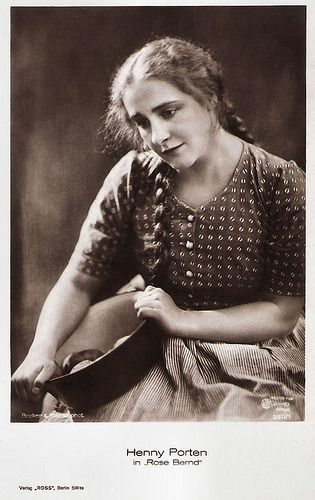
German postcard by Ross Verlag, Berlin, no. 350/1, 1919-1924. Photo: Becker & Maass, Berlin / Messter-Film. Publiciity for Rose Bernd (Alfred Halm, 1919).
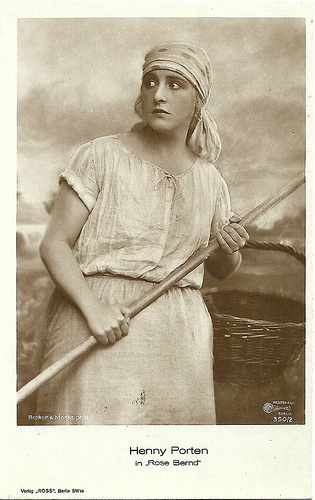
German postcard by Ross Verlag, no. 350/2. Photo: Becker & Maass, Berlin / Messter-Film. Publicity still for Rose Bernd (Alfred Halm, 1919).
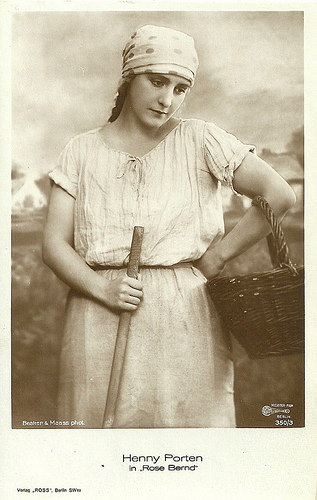
German postcard by Ross Verlag, no. 350/3. Photo: Becker & Maass, Berlin / Messter-Film. Publicity still for Rose Bernd (Alfred Halm, 1919).
Forbidden Love
Rose Bernd ( Henny Porten ) is a good-natured as well as a brave and loving peasant daughter. She has nursed in a self-sacrificing manner the seriously ill son of the well-to-do family Flamm until he dies.
His father, mayor Christoph Flamm (Alexander Wirth), is more and more interested in the young girl, and so he presses on Rose massively. Finally, she surrenders to the haughty seduction of the married and much older man. Meanwhile, Flame's wife (Ilka Grüning) is also very ill, she knows nothing about her husband's imitations. Finally, Rose Bernd gets pregnant from Flamm.
To all this, the young woman is also caught in the clutches of Arthur Streckmann ( Emil Jannings ), who is just as robust as he is bullish-rude and character-wrecked. He has observed Rose and the old Flamm at a tête-à-tête and now claims his 'right' at Rose. He threatens to betray her 'forbidden' love with Flamm and make it public, so he blackmails her to give in to him sexually. Yet, Rose remains firm, so Streckmann brutally rapes her.
A third candidate for Rose Bernd's favour is the pious bookkeeper August Keil (Paul Bildt). He officially asks Rose's father ( Werner Krauss ) for her hand, but his wooing is negated by the young woman's deaf ears. In the meantime Streckmann spreads rumours about Rose Bernd, which should bring her into disrepute. Then her father and the old Flamm accuse Streckmann of scandal and slander.
It comes to a court case. Rose Bernd, deeply ashamed of the events, denies the affair with Flamm as well as her pregnancy, and even out of shame commits perjury. As a last act of deep, inner turmoil and despair, Rose Bernd runs into the forest and gives birth to her child with her last efforts. Then she strangles her newborn child and returns to the city, shaken by febrile convulsions.
Rose Bernd was shot in August 1919. The premiere took place on 5 October 1919 at the Berlin Mozartsaal cinema as a charity matinee for poor, single mothers. General release started on 17 October 1919. Sets were by Hans Baluschek, cinematography by Willi Gabel, while director Alfred Halm also wrote the script, based on Gerhart Hauptmann's play.
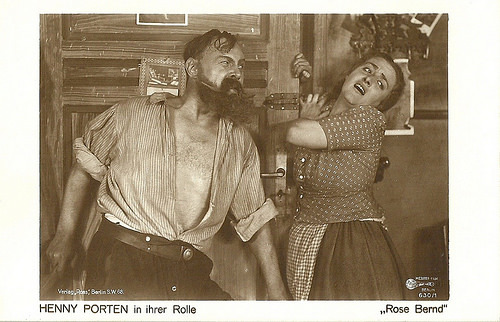
German postcard by Ross Verlag, no. 630/1. Photo: Becker & Maass, Berlin / Messter-Film. Publicity still for Rose Bernd (Alfred Halm, 1919), with Henny Porten and Emil Jannings .
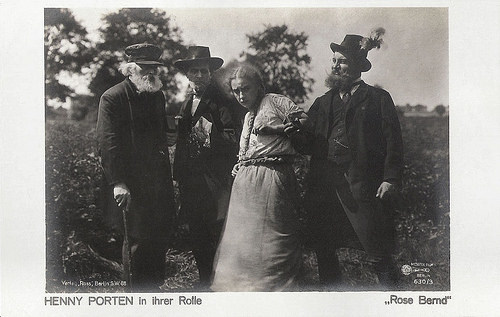
German postcard by Ross Verlag, no. 630/3. Photo: Messter-Film. Publicity still for Rose Bernd (Alfred Halm, 1919).
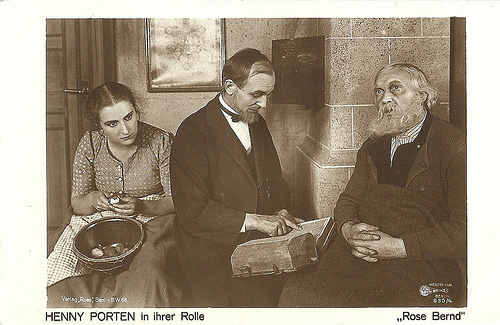
German postcard by Ross Verlag, no. 630/4. Photo: Becker & Maass, Berlin / Messter-Film. Publicity still for Rose Bernd (Alfred Halm, 1919), with Henny Porten and Werner Krauss (right).
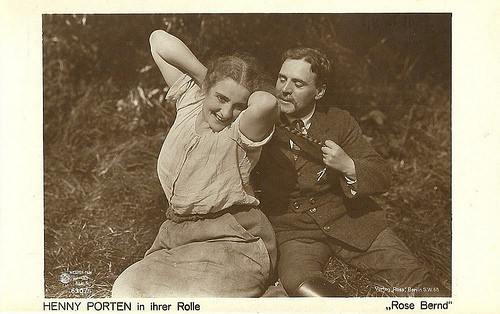
German postcard by Ross Verlag, no. 630/5. Photo: Becker & Maass, Berlin / Messter-Film. Publicity still for Rose Bernd (Alfred Halm, 1919), with Henny Porten and Alexander Wirth.
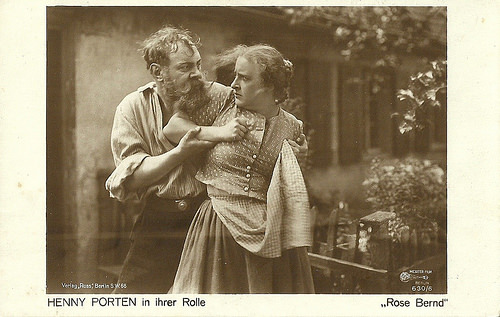
German postcard by Ross Verlag, no. 630/6. Photo: Becker & Maass, Berlin / Messter-Film. Publicity still for Rose Bernd (Alfred Halm, 1919), with Henny Porten and Emil Jannings .
Source: Wikipedia (German and English) and IMDb.

German postcard by Ross Verlag, Berlin, no. 350/1, 1919-1924. Photo: Becker & Maass, Berlin / Messter-Film. Publiciity for Rose Bernd (Alfred Halm, 1919).

German postcard by Ross Verlag, no. 350/2. Photo: Becker & Maass, Berlin / Messter-Film. Publicity still for Rose Bernd (Alfred Halm, 1919).

German postcard by Ross Verlag, no. 350/3. Photo: Becker & Maass, Berlin / Messter-Film. Publicity still for Rose Bernd (Alfred Halm, 1919).
Forbidden Love
Rose Bernd ( Henny Porten ) is a good-natured as well as a brave and loving peasant daughter. She has nursed in a self-sacrificing manner the seriously ill son of the well-to-do family Flamm until he dies.
His father, mayor Christoph Flamm (Alexander Wirth), is more and more interested in the young girl, and so he presses on Rose massively. Finally, she surrenders to the haughty seduction of the married and much older man. Meanwhile, Flame's wife (Ilka Grüning) is also very ill, she knows nothing about her husband's imitations. Finally, Rose Bernd gets pregnant from Flamm.
To all this, the young woman is also caught in the clutches of Arthur Streckmann ( Emil Jannings ), who is just as robust as he is bullish-rude and character-wrecked. He has observed Rose and the old Flamm at a tête-à-tête and now claims his 'right' at Rose. He threatens to betray her 'forbidden' love with Flamm and make it public, so he blackmails her to give in to him sexually. Yet, Rose remains firm, so Streckmann brutally rapes her.
A third candidate for Rose Bernd's favour is the pious bookkeeper August Keil (Paul Bildt). He officially asks Rose's father ( Werner Krauss ) for her hand, but his wooing is negated by the young woman's deaf ears. In the meantime Streckmann spreads rumours about Rose Bernd, which should bring her into disrepute. Then her father and the old Flamm accuse Streckmann of scandal and slander.
It comes to a court case. Rose Bernd, deeply ashamed of the events, denies the affair with Flamm as well as her pregnancy, and even out of shame commits perjury. As a last act of deep, inner turmoil and despair, Rose Bernd runs into the forest and gives birth to her child with her last efforts. Then she strangles her newborn child and returns to the city, shaken by febrile convulsions.
Rose Bernd was shot in August 1919. The premiere took place on 5 October 1919 at the Berlin Mozartsaal cinema as a charity matinee for poor, single mothers. General release started on 17 October 1919. Sets were by Hans Baluschek, cinematography by Willi Gabel, while director Alfred Halm also wrote the script, based on Gerhart Hauptmann's play.

German postcard by Ross Verlag, no. 630/1. Photo: Becker & Maass, Berlin / Messter-Film. Publicity still for Rose Bernd (Alfred Halm, 1919), with Henny Porten and Emil Jannings .

German postcard by Ross Verlag, no. 630/3. Photo: Messter-Film. Publicity still for Rose Bernd (Alfred Halm, 1919).

German postcard by Ross Verlag, no. 630/4. Photo: Becker & Maass, Berlin / Messter-Film. Publicity still for Rose Bernd (Alfred Halm, 1919), with Henny Porten and Werner Krauss (right).

German postcard by Ross Verlag, no. 630/5. Photo: Becker & Maass, Berlin / Messter-Film. Publicity still for Rose Bernd (Alfred Halm, 1919), with Henny Porten and Alexander Wirth.

German postcard by Ross Verlag, no. 630/6. Photo: Becker & Maass, Berlin / Messter-Film. Publicity still for Rose Bernd (Alfred Halm, 1919), with Henny Porten and Emil Jannings .
Source: Wikipedia (German and English) and IMDb.
Published on January 10, 2017 22:00
January 9, 2017
Luis Mariano
Luis Mariano (1914-1970) was a popular tenor of Spanish Basque origin, and was also a popular film star in the 1940s and 1950s. He reached celebrity in 1946 with the operetta La belle de Cadix. For more than ten years he dominated the French chanson and operetta world.
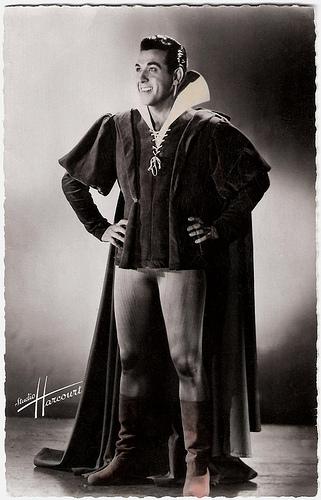
French postcard by Editions du Globe, Paris, no. 213. Photo: Studio Harcourt.
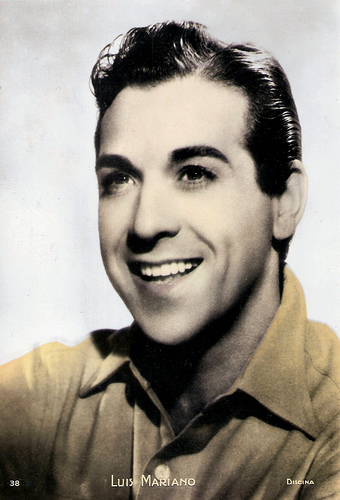
French postcard by Editions P.I., Paris, no. 38. Photo: Discina.
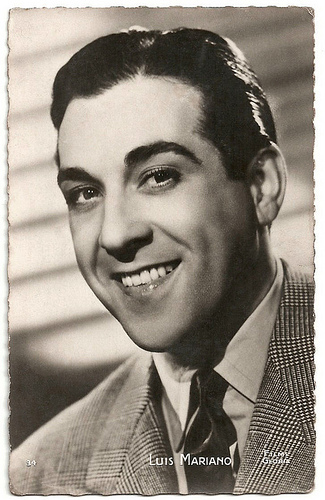
French postcard by Editions P.I., Paris, no. 34. Photo: Films Gloria.
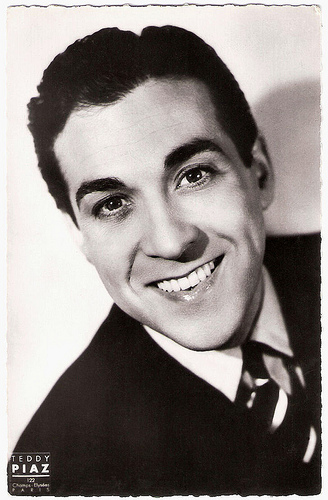
French postcard by Editions du Globe, no. 7. Photo: Teddy Piaz, Paris.
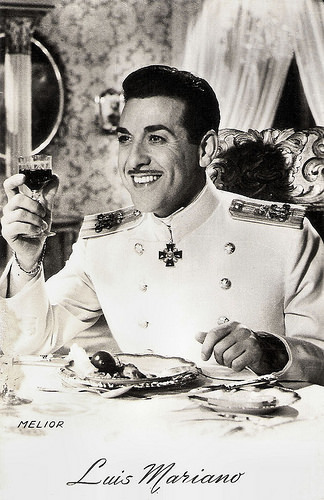
Dutch postcard by Uitg. Takken, Utrecht, no. AX 3143. Photo: Melior. Publicity still for Der Zarewitsch/The Little Czar (Arthur Maria Rabenalt, 1954).
The Beautiful Lady of Cadix
Luis Mariano was born as Mariano Eusebio González y García in Irún, Spain in 1914 as the son of a mechanic. His family moved to France at the start of the Spanish Civil War.
Luis studied at the École des Beaux-arts in Bordeaux. When he wanted to enter the Conservatoire de Bordeaux, his singing talent was discovered by singer Jeannine Micheau. She introduced him to Miguel Fontecha, who taught him further on.
Mariano made his debut at the Palais de Chaillot in 1943, as Ernesto in Don Pasquale. He also sang in variety shows on the radio and became well known. He met Francis Lopez and Raymond Vinci, and sang in their operetta La belle de Cadix/The Beautiful Lady of Cadix, which became his breakthrough. The run of the operetta continued for more than two years.
In 1943 he also made his first film appearances in Le Chant de l'exilé/The Song of the Exile (André Hugon, 1943) starring Tino Rossi , and L'escalier sans fin/The Stairs Without an End (Georges Lacombe, 1943) with Pierre Fresnay .
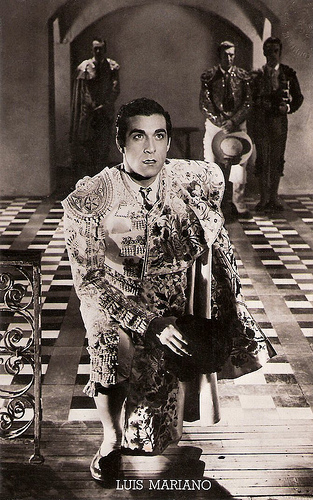
French postcard, no. 252. Photo: 20th Century Fox.
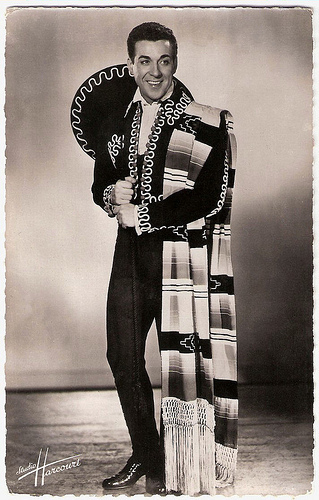
French postcard by Editions du Globe, Paris, no. 187. Photo: Studio Harcourt.
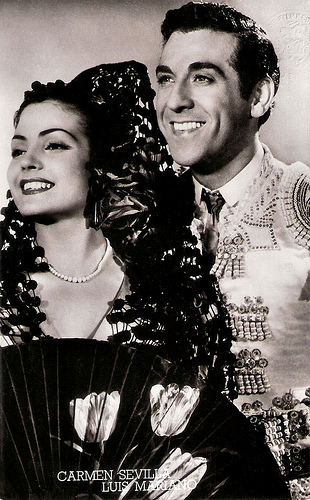
Dutch postcard. Photo: 20th Century Fox. Publicity still for Andalousie/Andalucia (Robert Vernay, 1951) with Carmen Sevilla .
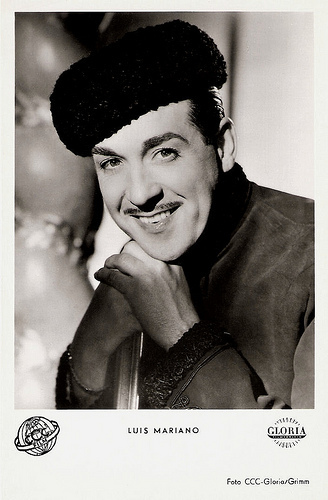
German postcard by Kunst und Bild, Berlin, no. A 1336. Photo: CCC / Gloria / Arthur Grimm. Publicity still for Der Zarewitsch/The Little Czar (Arthur Maria Rabenalt, 1954).
Mexican Singer
Rapidly, Luis Mariano became popular. For more than ten years he dominated the French chanson and operetta world.
In the cinema he starred with Martine Carol in the comedy Je n'aime que toi/I Like Only You (Pierre Montazel, 1949), and in the Spanish-French musical El Sueño de Andalucía/Andalousie/Andalusia (Luis Lucia, Robert Vernay, 1951).
The highpoint of his career was in the 1951-1952 season, when he was a big success as the ‘Mexican Singer’ in the operetta Le chanteur de Mexico, had a huge hit with the song Mexico, and made the musical film Violetas imperiales/Violettes impériales (Richard Pottier, 1952) with Carmen Sevilla .
In total he made some twenty musical films. The following years he toured through Europe, and North and South America. When the yé-yé (the French beat music) conquered the French radio and TV in 1958-1960, Luis Mariano decided to direct his focus entirely on the operetta.
His last film appearance was a bit part in the comedy Les pieds dans le plâtre/Feet in the plaster (Jacques Fabbri, Pierre Lary, 1965).
Luis Mariano died in 1970 in Paris of cerebral hemorrhage. He was only 55. In 1996 his music was featured prominently in the award winning Belgian film Le Huitième Jour/The Eighth Day (Jaco van Dormael, 1996) in which he is played by Laszlo Harmati during the hallucination scenes.
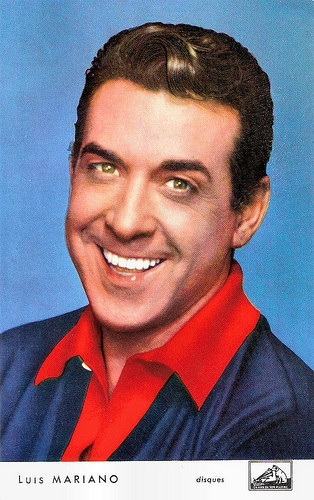
French postcard by JPB. Photo: disques La Voix de son Maitre.
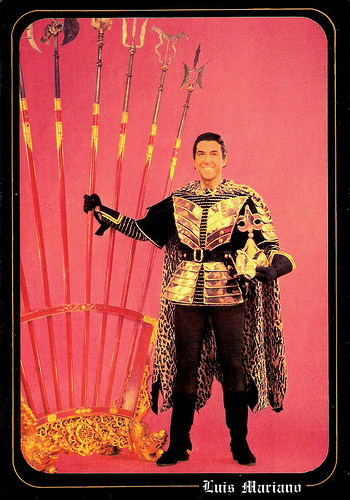
French postcard by Editions Rameaux, Ascain, no. 85/391. Photo: Patxi Lacan. Publicity still for the stage operetta Le Secret de Marco Polo/The Secret of Marco Polo (1959).
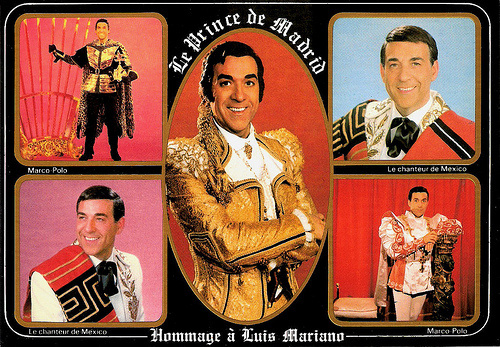
French postcard by Editions Rameaux, Ascain. Photo: Patxi Lacan.
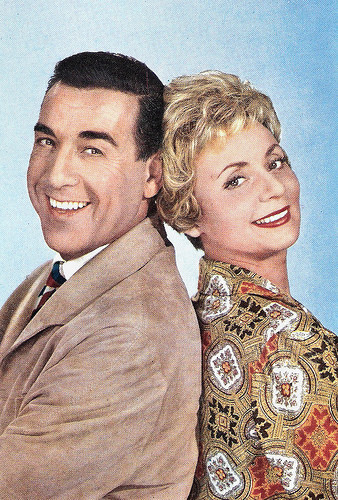
With Annie Cordy . French promotion card by S.I.A.T., Paris for Pathé. On the backside the text of the song Visa pour l'amour.
Luis Mariano sings Mexico. Source: Zdrobygdo (YouTube).
Sources: Mariano Lacan (Luis Mariano Official Website - French), Wikipedia, and .

French postcard by Editions du Globe, Paris, no. 213. Photo: Studio Harcourt.

French postcard by Editions P.I., Paris, no. 38. Photo: Discina.

French postcard by Editions P.I., Paris, no. 34. Photo: Films Gloria.

French postcard by Editions du Globe, no. 7. Photo: Teddy Piaz, Paris.

Dutch postcard by Uitg. Takken, Utrecht, no. AX 3143. Photo: Melior. Publicity still for Der Zarewitsch/The Little Czar (Arthur Maria Rabenalt, 1954).
The Beautiful Lady of Cadix
Luis Mariano was born as Mariano Eusebio González y García in Irún, Spain in 1914 as the son of a mechanic. His family moved to France at the start of the Spanish Civil War.
Luis studied at the École des Beaux-arts in Bordeaux. When he wanted to enter the Conservatoire de Bordeaux, his singing talent was discovered by singer Jeannine Micheau. She introduced him to Miguel Fontecha, who taught him further on.
Mariano made his debut at the Palais de Chaillot in 1943, as Ernesto in Don Pasquale. He also sang in variety shows on the radio and became well known. He met Francis Lopez and Raymond Vinci, and sang in their operetta La belle de Cadix/The Beautiful Lady of Cadix, which became his breakthrough. The run of the operetta continued for more than two years.
In 1943 he also made his first film appearances in Le Chant de l'exilé/The Song of the Exile (André Hugon, 1943) starring Tino Rossi , and L'escalier sans fin/The Stairs Without an End (Georges Lacombe, 1943) with Pierre Fresnay .

French postcard, no. 252. Photo: 20th Century Fox.

French postcard by Editions du Globe, Paris, no. 187. Photo: Studio Harcourt.

Dutch postcard. Photo: 20th Century Fox. Publicity still for Andalousie/Andalucia (Robert Vernay, 1951) with Carmen Sevilla .

German postcard by Kunst und Bild, Berlin, no. A 1336. Photo: CCC / Gloria / Arthur Grimm. Publicity still for Der Zarewitsch/The Little Czar (Arthur Maria Rabenalt, 1954).
Mexican Singer
Rapidly, Luis Mariano became popular. For more than ten years he dominated the French chanson and operetta world.
In the cinema he starred with Martine Carol in the comedy Je n'aime que toi/I Like Only You (Pierre Montazel, 1949), and in the Spanish-French musical El Sueño de Andalucía/Andalousie/Andalusia (Luis Lucia, Robert Vernay, 1951).
The highpoint of his career was in the 1951-1952 season, when he was a big success as the ‘Mexican Singer’ in the operetta Le chanteur de Mexico, had a huge hit with the song Mexico, and made the musical film Violetas imperiales/Violettes impériales (Richard Pottier, 1952) with Carmen Sevilla .
In total he made some twenty musical films. The following years he toured through Europe, and North and South America. When the yé-yé (the French beat music) conquered the French radio and TV in 1958-1960, Luis Mariano decided to direct his focus entirely on the operetta.
His last film appearance was a bit part in the comedy Les pieds dans le plâtre/Feet in the plaster (Jacques Fabbri, Pierre Lary, 1965).
Luis Mariano died in 1970 in Paris of cerebral hemorrhage. He was only 55. In 1996 his music was featured prominently in the award winning Belgian film Le Huitième Jour/The Eighth Day (Jaco van Dormael, 1996) in which he is played by Laszlo Harmati during the hallucination scenes.

French postcard by JPB. Photo: disques La Voix de son Maitre.

French postcard by Editions Rameaux, Ascain, no. 85/391. Photo: Patxi Lacan. Publicity still for the stage operetta Le Secret de Marco Polo/The Secret of Marco Polo (1959).

French postcard by Editions Rameaux, Ascain. Photo: Patxi Lacan.

With Annie Cordy . French promotion card by S.I.A.T., Paris for Pathé. On the backside the text of the song Visa pour l'amour.
Luis Mariano sings Mexico. Source: Zdrobygdo (YouTube).
Sources: Mariano Lacan (Luis Mariano Official Website - French), Wikipedia, and .
Published on January 09, 2017 22:00
January 8, 2017
Victor Varconi
Handsome Victor Varconi (1891–1976) was a highly successful matinee idol of the Hungarian-Austrian and German silent cinema in the 1910s and early 1920s. Later he was the first Hungarian actor to become a Hollywood star until the sound film completely altered the course of his career.
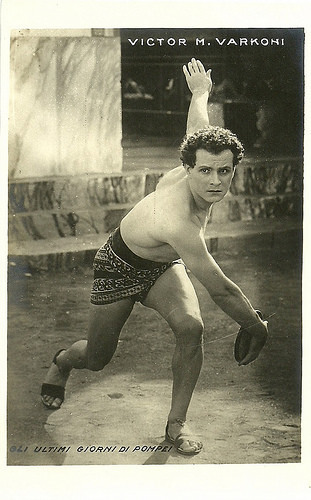
Italian postcard by C. Chierichetti, Milano. Photo: Grandi Films, Roma. Publicity still for the Italian-German silent film Gli ultimi giorni di Pompeii/The Last Days of Pompeii (Amleto Palermi, Carmine Gallone, 1926), starring Victor Varconi as Glaucus, on the photo he is training at the gymnasium. The film was one of the many adaptations of the novel The Last Days of Pompeii (1834) by Edward George Bulwer-Lytton. Sets were by Vittorio Cafiero, costumes by Duilio Cambellotti.
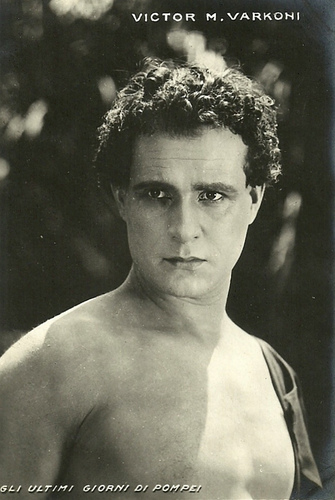
Italian postcard by C. Chierichetti, Milano, no. 8. Photo: Grandi Films, Roma. Publicity still for the Italian-German silent film Gli ultimi giorni di Pompeii/The Last Days of Pompeii (Amleto Palermi, Carmine Gallone, 1926), starring Victor Varconi as Glaucus.

Austrian postcard by Iris-Verlag, no. 360/1. Photo: Paramount-Film.

Austrian postcard by Iris Verlag, no. 5062. Photo: Cecil B. de Mille-Studio. Publicity still for The King of Kings (Cecil B. de Mille, 1927).
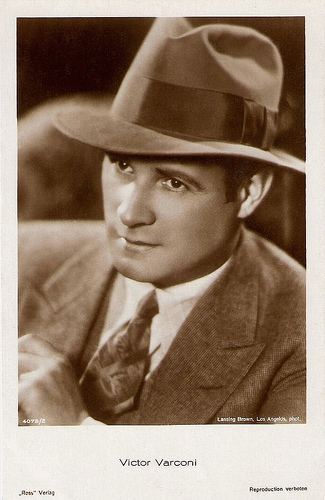
German postcard by Ross Verlag, no. 4075/2, 1929-1930. Photo: Lansing Brown, Los Angeles.
Devilish Good Looks
Victor Varconi was born Mihály Várkonyi in Kisvárda, Austria-Hungary (now Hungary) in 1891. He was born into a farming family on the Hungarian/Romanian border. He attended classes at Budapest's commercial college and at the dramatic school.
The young good-looking actor thrived for a time on the Transylvanian stage, where he played leads in such productions as Liliom at the Hungarian National Theatre in Budapest. His rising popularity as a matinee idol led to film roles, and he made his debut in Sárga csikó/Son of the Pusta (Félix Vanyl, 1913).
Other of his silent Hungarian films were Bánk Bán (Mihály Kertész aka Michael Curtiz, 1914) based on the play by József Katona, Mágia/Magic (Sándor Korda aka Alexander Korda, 1917), Szent Péter esernyöje/St. Peter's Umbrella (Alexander Korda, 1917) and Fehér rózsa/White Rose (Alexander Korda, 1919) starring Maria Corda , the director’s wife. Unfortunately nearly all these early films got lost.
After World War I, under the Horthy regime, Korda and many other film makers fled to Vienna, and Varconi followed them. He changed his marquee name to the more internationally friendly Michael Várkonyi and branched out into German and Austrian films. He showed impressive performances in Aus den Tiefen der Großstadt/ From the depths of the big city (Fred Sauer, 1920) and Nachtbesuch in der Northernbank/Night visit in the Northernbank (Karl Grune, 1921).
Then followed such films as Arme Violetta/Camille (Paul H. Stein, 1921) a silent version of La Traviata starring Pola Negri , Herren der Meere/Masters of the Sea (Alexander Korda, 1922), Versunkene Welten/Sunk worlds (Siegfried Philippi, 1922) with Ria Jende , and Namenlos/Nameless (Michael Curtiz, 1923) with Mary Kid .
A huge success was the biblical epic Sodom und Gomorrha/Queen of Sin (Michael Curtiz, 1922) with Lucy Doraine . IMDb reviewer Nora Nettlerash writes about his performance in this film: “with his devilish good looks he doesn't really need to act here, and with his commanding presence he makes a great angel of the Lord”.

Hungarian postcard by B.J., Budapest.
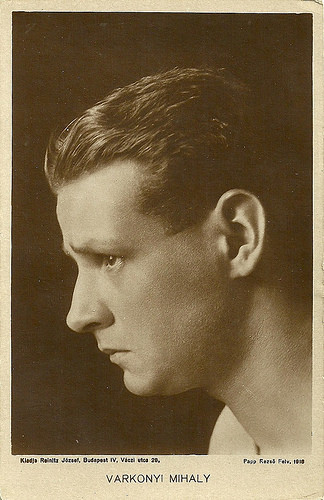
Hungarian postcard by Kiadja Reinitz Joszef, Budapest. Photo: Papp Reszo Felv., 1918.

Hungarian postcard by Shinhazi Elet, Budapest, no. 16. Photo: Labori Miklos, Budapest.
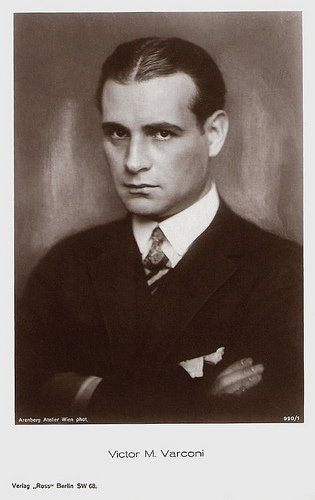
German postcard by Ross Verlag, no. 990/1, 1925-1926. Photo: Arenberg Atelier, Wien (Vienna).

German postcard by Ross Verlag, no. 990/2, 1925-1926. Photo: Arenberg Atelier, Wien.
Trying His Luck in Hollywood
In 1924, because of the ever-shifting political climate of Europe, Michael Várkonyi moved to America to try his luck in Hollywood. First he played a supporting part in Poisoned Paradise (Louis J. Gasnier, 1924) starring It-girl Clara Bow.
Then he was signed by Cecil B. DeMille's company on his exceptional performance in Sodom und Gomorrha (1922). DeMille cast him as a wealthy American tin factory manager in Triumph (Cecil B. DeMille, 1924) opposite established star Leatrice Joy. He was billed now as Victor Varconi.
For DeMille's company, the smoothly handsome Varconi then played in the comedy Changing Husbands (Frank Urson, 1924) again opposite Leatrice Joy, had a character role as a bookkeeper in the afterworld in Feet of Clay (Cecil B. DeMille, 1924), later he was a Russian prince in The Volga Boatman (Cecil B. DeMille, 1926) starring William Boyd, and finally, a disgruntled Pontius Pilate in the biblical epic The King of Kings (Cecil B. DeMille, 1929).
Temporarily he returned to Europe. In Germany he reunited with director Alexander Korda and his wife Maria Corda for the comedy-drama Der Tänzer meiner Frau/Dance Fever (Alexander Korda, 1925). With Corda he also acted in the two Italian productions L'uomo piu allegro di Vienna/The happiest man in Vienna (Amleto Palermi, 1926) and the lavish spectacle Gli ultimi giorni di Pompeii/The Last Days of Pompeii (Carmine Gallone, Amleto Palermi, 1926) starring Italian diva Rina De Liguoro .
Back in Hollywood, the elegant and impeccably mannered Varconi went on to share the screen with some of the loveliest and talented ladies of silent Hollywood, including Agnes Ayres, Marie Prevost, and Jetta Goudal .
Notable is his portrayal of cuckolded husband Amos opposite Phyllis Haver's wild jazz-loving and boozing Roxie Hart in the silent Chicago (Frank Urson, 1927). His last major silent role was that of Lord Horatio Nelson in The Divine Lady (Frank Lloyd, 1929) co-starring Oscar-nominated Corinne Griffith as Lady Emma Hamilton.
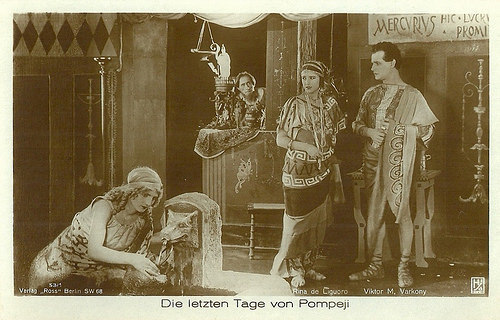
German postcard by Ross Verlag, no. 53/1. Photo: Hisa Film. Publicity still for the Italian silent epic Gi ultimi giorni di Pompei (Carmine Gallone, Amleto Palermi, 1926). Glaucus (Victor Varconi) and the rich Julia (Lia Maris, not Rina De Liguoro as this card pretends) meet on the streets of Pompeii, so the blind flower girl Nydia ( Maria Corda ) hears Glaucus is back in town. Set designer Vittorio Cafiero copied various original artefacts from Pompeii for this films, such as here the small burner held up by satyrs in the shop.
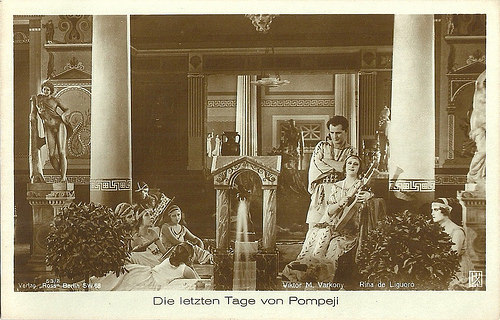
German postcard by Ross Verlag, no. 53/2. Photo: Hisa Film. Publicity still for the Italian silent epic Gi ultimi giorni di Pompei (Carmine Gallone, Amleto Palermi, 1926).
Glaucus (Victor Varconi) listens to beautiful and rich Greek Ione ( Rina De Liguoro ) playing the harp. The statue left was copied from an original Roman one.
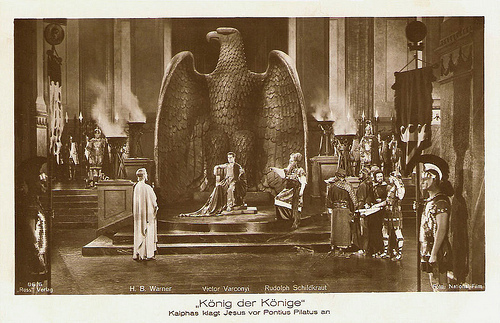
German postcard by Ross Verlag, no. 86/6. Photo: National-Film. Publicity still for King of Kings (Cecil B. De Mille, 1927) with Victor Varconi, H.B. Warner and Rudolph Schildkraut. Caption: Caiphas accuses Jesus before Pontius Pilate.
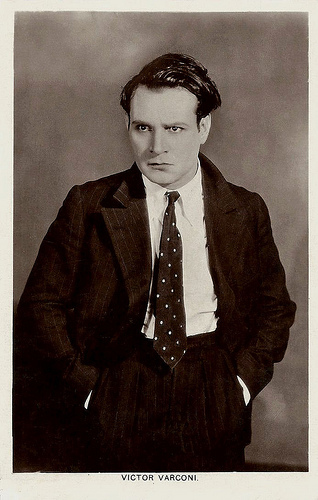
British postcard in the Picturegoer Series no. 338, London.
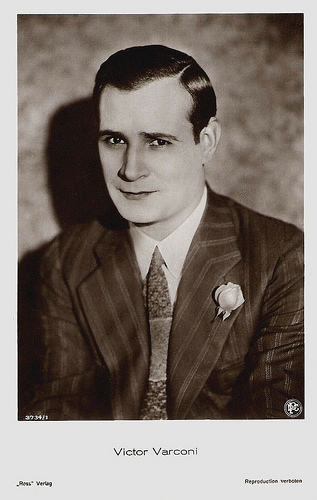
German postcard by Ross Verlag, no. 3734/1, 1928-1929. Photo: DPC.

German postcard by Ross Verlag, no. 4279/1, 1929-1930. Photo: Lansing Brown, Los Angeles.
Transition to the Talkies
At the peak of his career as a romantic leading man, Victor Varconi had to face transition from the silent movies to the talkies. It completely altered the course of his career. He had a nice decent voice for sound film but his accent was noticeably thick. He no longer did become offers for leading parts.
Temporarily he worked in European silent films, such as the Polish Kult ciala/The Cult of the Body (Michal Waszynski, 1930) and the German Mein Herz gehört Dir.../My heart belongs to you (Max Reichmann, 1930) with Camilla Horn .
Back in Hollywood, he regressed slightly to suave ethnic character roles, such as in the Charlie Chan mystery The Black Camel (Hamilton MacFadden, 1931) starring Warner Oland. He often played foreign or royal dignitaries, European adventurers or roguish gigolos. He also starred in English-language versions of Anglo-German co-productions, such as Der Rebell/The Rebel (Luis Trenker, Edwin H. Knopf, 1933) starring Luis Trenker .
The forced move to character roles probably added years to his Hollywood life. During World War II Hollywood utilised his talents playing nefarious Axis commanders in spy intrigue and war dramas. In The Hitler Gang (John Farrow, 1944), he was quite skillful portraying Nazi Deputy Rudolf Hess. Varconi also appeared in many of his old boss Cecil DeMille's sound epics such as The Plainsman (Cecil B. DeMille, 1936) (as Indian chief Painted Horse), Reap the Wild Wind (Cecil B. DeMille, 1942) starring Ray Milland , Unconquered (1947, Cecil B. DeMille) with Gary Cooper, and Samson and Delilah (Cecil B. DeMille, 1949) starring Hedy Lamarr .
After 1949 Varconi scaled down his workload. He also worked on the New York City stage and wrote for radio. Among his Shakespearean theatre endeavours were roles in Hamlet, Romeo and Juliet, Antony and Cleopatra and Richard III. He also moved occasionally into TV in the 1950s.
Varconi did another film part in the Sci-Fi movie The Man Who Turned to Stone (László Kardos, 1957) starring Victor Jory. The plot was about a group of 18th-century scientists, who have remained young after all these centuries by using electricity to suck the life out of young women. After a supporting part in another Sci-Fi thriller, The Atomic Submarine (Spencer Gordon Bennet, 1960), he retired.
Victor Varconi had appeared in 120 films. He published his memoirs It's Not Enough to Be Hungarian, just before his death. In 1976, Victor Varconi died from a heart attack in Santa Barbara, California, at the age of 85. He was married twice. His second wife was stage actress Anna Aranyosy.

Polish postcard, no. 1244. Photo: publicity still for Kult ciala/The cult of the body (Michal Waszynski, 1930) with Agnes Petersen .
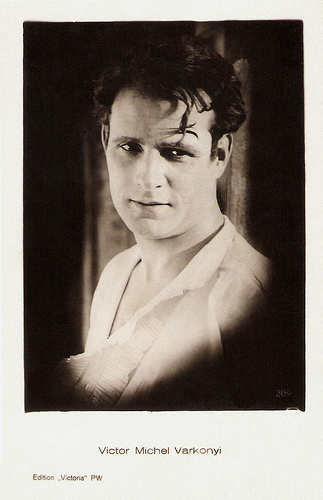
Polish postcard by Edition Victoria PW, no. 209.

Austrian postcard by Iris Verlag, no. 5061, 1929-1930. Photo: Cecil B. DeMille Studio.

German postcard by Ross Verlag, no. 3301/2, 1928-1929. Photo: Angelo Photos.
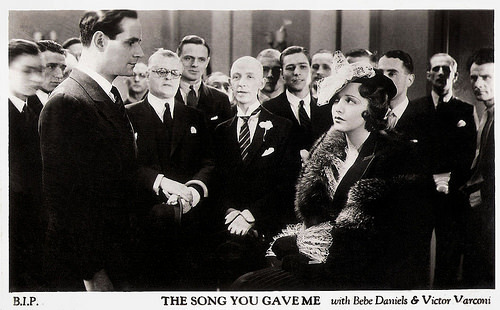
British postcard. Photo: B. I. P. Publicity still for The Song You Gave Me (Paul L. Stein, 1933) with Bebe Daniels .
Sources: Hal Erickson (AllMovie), Thomas Staedeli (Cyranos), (IMDb), Wikipedia and .

Italian postcard by C. Chierichetti, Milano. Photo: Grandi Films, Roma. Publicity still for the Italian-German silent film Gli ultimi giorni di Pompeii/The Last Days of Pompeii (Amleto Palermi, Carmine Gallone, 1926), starring Victor Varconi as Glaucus, on the photo he is training at the gymnasium. The film was one of the many adaptations of the novel The Last Days of Pompeii (1834) by Edward George Bulwer-Lytton. Sets were by Vittorio Cafiero, costumes by Duilio Cambellotti.

Italian postcard by C. Chierichetti, Milano, no. 8. Photo: Grandi Films, Roma. Publicity still for the Italian-German silent film Gli ultimi giorni di Pompeii/The Last Days of Pompeii (Amleto Palermi, Carmine Gallone, 1926), starring Victor Varconi as Glaucus.

Austrian postcard by Iris-Verlag, no. 360/1. Photo: Paramount-Film.

Austrian postcard by Iris Verlag, no. 5062. Photo: Cecil B. de Mille-Studio. Publicity still for The King of Kings (Cecil B. de Mille, 1927).

German postcard by Ross Verlag, no. 4075/2, 1929-1930. Photo: Lansing Brown, Los Angeles.
Devilish Good Looks
Victor Varconi was born Mihály Várkonyi in Kisvárda, Austria-Hungary (now Hungary) in 1891. He was born into a farming family on the Hungarian/Romanian border. He attended classes at Budapest's commercial college and at the dramatic school.
The young good-looking actor thrived for a time on the Transylvanian stage, where he played leads in such productions as Liliom at the Hungarian National Theatre in Budapest. His rising popularity as a matinee idol led to film roles, and he made his debut in Sárga csikó/Son of the Pusta (Félix Vanyl, 1913).
Other of his silent Hungarian films were Bánk Bán (Mihály Kertész aka Michael Curtiz, 1914) based on the play by József Katona, Mágia/Magic (Sándor Korda aka Alexander Korda, 1917), Szent Péter esernyöje/St. Peter's Umbrella (Alexander Korda, 1917) and Fehér rózsa/White Rose (Alexander Korda, 1919) starring Maria Corda , the director’s wife. Unfortunately nearly all these early films got lost.
After World War I, under the Horthy regime, Korda and many other film makers fled to Vienna, and Varconi followed them. He changed his marquee name to the more internationally friendly Michael Várkonyi and branched out into German and Austrian films. He showed impressive performances in Aus den Tiefen der Großstadt/ From the depths of the big city (Fred Sauer, 1920) and Nachtbesuch in der Northernbank/Night visit in the Northernbank (Karl Grune, 1921).
Then followed such films as Arme Violetta/Camille (Paul H. Stein, 1921) a silent version of La Traviata starring Pola Negri , Herren der Meere/Masters of the Sea (Alexander Korda, 1922), Versunkene Welten/Sunk worlds (Siegfried Philippi, 1922) with Ria Jende , and Namenlos/Nameless (Michael Curtiz, 1923) with Mary Kid .
A huge success was the biblical epic Sodom und Gomorrha/Queen of Sin (Michael Curtiz, 1922) with Lucy Doraine . IMDb reviewer Nora Nettlerash writes about his performance in this film: “with his devilish good looks he doesn't really need to act here, and with his commanding presence he makes a great angel of the Lord”.

Hungarian postcard by B.J., Budapest.

Hungarian postcard by Kiadja Reinitz Joszef, Budapest. Photo: Papp Reszo Felv., 1918.

Hungarian postcard by Shinhazi Elet, Budapest, no. 16. Photo: Labori Miklos, Budapest.

German postcard by Ross Verlag, no. 990/1, 1925-1926. Photo: Arenberg Atelier, Wien (Vienna).

German postcard by Ross Verlag, no. 990/2, 1925-1926. Photo: Arenberg Atelier, Wien.
Trying His Luck in Hollywood
In 1924, because of the ever-shifting political climate of Europe, Michael Várkonyi moved to America to try his luck in Hollywood. First he played a supporting part in Poisoned Paradise (Louis J. Gasnier, 1924) starring It-girl Clara Bow.
Then he was signed by Cecil B. DeMille's company on his exceptional performance in Sodom und Gomorrha (1922). DeMille cast him as a wealthy American tin factory manager in Triumph (Cecil B. DeMille, 1924) opposite established star Leatrice Joy. He was billed now as Victor Varconi.
For DeMille's company, the smoothly handsome Varconi then played in the comedy Changing Husbands (Frank Urson, 1924) again opposite Leatrice Joy, had a character role as a bookkeeper in the afterworld in Feet of Clay (Cecil B. DeMille, 1924), later he was a Russian prince in The Volga Boatman (Cecil B. DeMille, 1926) starring William Boyd, and finally, a disgruntled Pontius Pilate in the biblical epic The King of Kings (Cecil B. DeMille, 1929).
Temporarily he returned to Europe. In Germany he reunited with director Alexander Korda and his wife Maria Corda for the comedy-drama Der Tänzer meiner Frau/Dance Fever (Alexander Korda, 1925). With Corda he also acted in the two Italian productions L'uomo piu allegro di Vienna/The happiest man in Vienna (Amleto Palermi, 1926) and the lavish spectacle Gli ultimi giorni di Pompeii/The Last Days of Pompeii (Carmine Gallone, Amleto Palermi, 1926) starring Italian diva Rina De Liguoro .
Back in Hollywood, the elegant and impeccably mannered Varconi went on to share the screen with some of the loveliest and talented ladies of silent Hollywood, including Agnes Ayres, Marie Prevost, and Jetta Goudal .
Notable is his portrayal of cuckolded husband Amos opposite Phyllis Haver's wild jazz-loving and boozing Roxie Hart in the silent Chicago (Frank Urson, 1927). His last major silent role was that of Lord Horatio Nelson in The Divine Lady (Frank Lloyd, 1929) co-starring Oscar-nominated Corinne Griffith as Lady Emma Hamilton.

German postcard by Ross Verlag, no. 53/1. Photo: Hisa Film. Publicity still for the Italian silent epic Gi ultimi giorni di Pompei (Carmine Gallone, Amleto Palermi, 1926). Glaucus (Victor Varconi) and the rich Julia (Lia Maris, not Rina De Liguoro as this card pretends) meet on the streets of Pompeii, so the blind flower girl Nydia ( Maria Corda ) hears Glaucus is back in town. Set designer Vittorio Cafiero copied various original artefacts from Pompeii for this films, such as here the small burner held up by satyrs in the shop.

German postcard by Ross Verlag, no. 53/2. Photo: Hisa Film. Publicity still for the Italian silent epic Gi ultimi giorni di Pompei (Carmine Gallone, Amleto Palermi, 1926).
Glaucus (Victor Varconi) listens to beautiful and rich Greek Ione ( Rina De Liguoro ) playing the harp. The statue left was copied from an original Roman one.

German postcard by Ross Verlag, no. 86/6. Photo: National-Film. Publicity still for King of Kings (Cecil B. De Mille, 1927) with Victor Varconi, H.B. Warner and Rudolph Schildkraut. Caption: Caiphas accuses Jesus before Pontius Pilate.

British postcard in the Picturegoer Series no. 338, London.

German postcard by Ross Verlag, no. 3734/1, 1928-1929. Photo: DPC.

German postcard by Ross Verlag, no. 4279/1, 1929-1930. Photo: Lansing Brown, Los Angeles.
Transition to the Talkies
At the peak of his career as a romantic leading man, Victor Varconi had to face transition from the silent movies to the talkies. It completely altered the course of his career. He had a nice decent voice for sound film but his accent was noticeably thick. He no longer did become offers for leading parts.
Temporarily he worked in European silent films, such as the Polish Kult ciala/The Cult of the Body (Michal Waszynski, 1930) and the German Mein Herz gehört Dir.../My heart belongs to you (Max Reichmann, 1930) with Camilla Horn .
Back in Hollywood, he regressed slightly to suave ethnic character roles, such as in the Charlie Chan mystery The Black Camel (Hamilton MacFadden, 1931) starring Warner Oland. He often played foreign or royal dignitaries, European adventurers or roguish gigolos. He also starred in English-language versions of Anglo-German co-productions, such as Der Rebell/The Rebel (Luis Trenker, Edwin H. Knopf, 1933) starring Luis Trenker .
The forced move to character roles probably added years to his Hollywood life. During World War II Hollywood utilised his talents playing nefarious Axis commanders in spy intrigue and war dramas. In The Hitler Gang (John Farrow, 1944), he was quite skillful portraying Nazi Deputy Rudolf Hess. Varconi also appeared in many of his old boss Cecil DeMille's sound epics such as The Plainsman (Cecil B. DeMille, 1936) (as Indian chief Painted Horse), Reap the Wild Wind (Cecil B. DeMille, 1942) starring Ray Milland , Unconquered (1947, Cecil B. DeMille) with Gary Cooper, and Samson and Delilah (Cecil B. DeMille, 1949) starring Hedy Lamarr .
After 1949 Varconi scaled down his workload. He also worked on the New York City stage and wrote for radio. Among his Shakespearean theatre endeavours were roles in Hamlet, Romeo and Juliet, Antony and Cleopatra and Richard III. He also moved occasionally into TV in the 1950s.
Varconi did another film part in the Sci-Fi movie The Man Who Turned to Stone (László Kardos, 1957) starring Victor Jory. The plot was about a group of 18th-century scientists, who have remained young after all these centuries by using electricity to suck the life out of young women. After a supporting part in another Sci-Fi thriller, The Atomic Submarine (Spencer Gordon Bennet, 1960), he retired.
Victor Varconi had appeared in 120 films. He published his memoirs It's Not Enough to Be Hungarian, just before his death. In 1976, Victor Varconi died from a heart attack in Santa Barbara, California, at the age of 85. He was married twice. His second wife was stage actress Anna Aranyosy.

Polish postcard, no. 1244. Photo: publicity still for Kult ciala/The cult of the body (Michal Waszynski, 1930) with Agnes Petersen .

Polish postcard by Edition Victoria PW, no. 209.

Austrian postcard by Iris Verlag, no. 5061, 1929-1930. Photo: Cecil B. DeMille Studio.

German postcard by Ross Verlag, no. 3301/2, 1928-1929. Photo: Angelo Photos.

British postcard. Photo: B. I. P. Publicity still for The Song You Gave Me (Paul L. Stein, 1933) with Bebe Daniels .
Sources: Hal Erickson (AllMovie), Thomas Staedeli (Cyranos), (IMDb), Wikipedia and .
Published on January 08, 2017 22:00
January 7, 2017
Exported to the USA: Angela Lansbury
Strawberry blonde and blue-eyed Angela Lansbury (1925) is a British-born character actress, who works in the United States since the Second World War began. She began her career as a teenager in the films Gaslight (1944) and The Picture of Dorian Gray (1945). She was later known for her mother roles in films like The Manchurian Candidate (1962). In the 1980s, she obtained her greatest fame on TV as Jessica Fletcher in the mystery series Murder, She Wrote (1984).
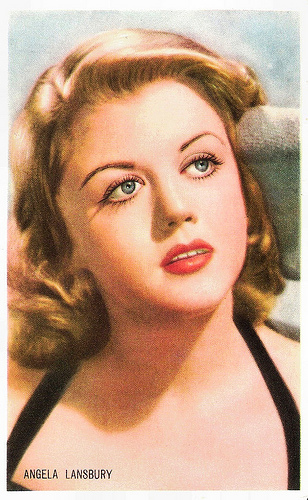
Belgian collectors card by Kwatta, Bois - D'Haine, no. C 301. Photo: Metro-Goldwyn-Mayer. Publicity still for The Three Musketeers (George Sidney, 1948).
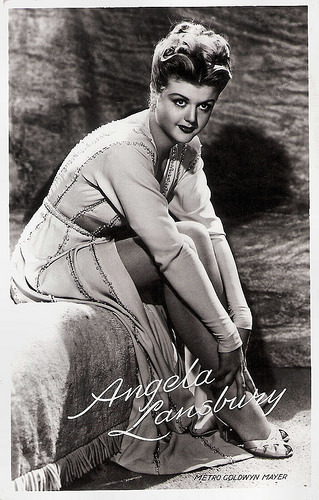
Dutch postcard by Takken, no. 166. Photo: Metro-Goldwyn-Mayer.
The Other Woman
Angela Brigid Lansbury was born Regent Park, London in 1925. She was the daughter of actress Moyna MacGill, and timber merchant and politician Edward Lansbury, who died when she was only 9 years old.
Her grandfather, George Lansbury, was the British Labour Party leader in the 1930s. Her younger twin brothers are art director and producer Edgar Lansbury and TV producer Bruce Lansbury, and her older half-sister is Isolde Denham.
Lansbury studied acting from her youth. With her mother and brothers, she departed for the United States in 1940, as the Second World War began. In New York City, Lansbury received a scholarship to study drama at the Lucy Fagan school. She was contracted by MGM while still a teenager.
Lansbury was nominated for an Academy Award for her first film, Gaslight (George Cukor, 1944). Opposite Ingrid Bergman and Charles Boyer , she played the house maid Nancy. Two pictures later, she was again nominated for Best Supporting Actress, this time for playing dance hall lady Sibyl Vane in The Picture of Dorian Gray (Albert Lewin, 1945), based on Oscar Wilde’s story of a man who makes a supernatural pact to remain young at a high cost. She did win a Golden Globe for her supporting role in this film.
Lansbury landed other major roles, including that of Elizabeth Taylor ’s older sister in National Velvet (Clarence Brown, 1944) and opposite Judy Garland in the musical The Harvey Girls (George Sidney, 1946). Now established as a supporting player of quality, she began a long career, often as 'the other woman' in major productions and as the leading lady in lesser films.
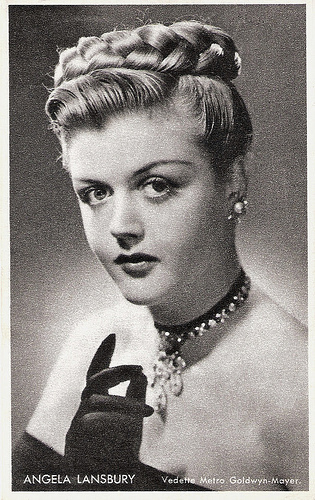
Belgian collectors card by Kwatta, Bois - D'Haine, no. C 8. Photo: Metro-Goldwyn-Mayer.
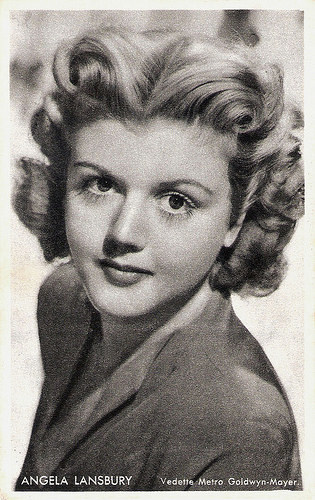
Belgian collectors card by Kwatta, Bois - D'Haine. Photo: Metro-Goldwyn-Mayer.
The manipulating mother
Angela Lansbury became an American citizen in 1951. She appeared as Princess Gwendolyn opposite Danny Kaye in the comedy film The Court Jester (Melvin Frank, 1956), as Minnie Littlejohn in The Long Hot Summer (Martin Ritt, 1958), and as Mabel Claremont in The Reluctant Debutante (Vincente Minelli, 1958).
Her features, while not at all old-appearing, gave her an air of maturity that allowed her to pass as much older than she actually was. She began playing mother roles, often to players of her own age, while yet in her thirties. Lansbury played Elvis Presley's mother in Blue Hawaii (Norman Taurog, 1961), despite only being 10 years older than him.
She was also the manipulating mother of Laurence Harvey in the Cold War thriller The Manchurian Candidate (John Frankenheimer, 1962), while in real life being scarcely three years Harvey's senior. The latter brought her a third Academy Award nomination for supporting actress.
Other film roles included The Amorous Adventures of Moll Flanders (Terence Young, 1965) starring Kim Novak , and the biblical epic The Greatest Story Ever Told (George Stevens, 1965), featuring Max von Sydow as Jesus. In the partially-animated Disney musical Bedknobs and Broomsticks (Robert Stevenson, 1971), she played the witch Miss Price.
However, she concentrated more and more on stage work. She made her Broadway debut in 1957 with the play Hotel Paradiso, a French burlesque set in Paris, directed by Peter Glenville. A role in the drama A Taste of Honey (1961) and the Stephen Sondheim musical Anyone Can Whistle (1964) followed.
She achieved notable success in a number of Broadway musicals. She has been the co-recipient of 4 Grammy Awards for her leading roles in the musicals Mame (1966), Dear World (1969), Gypsy (1975) and Sweeney Todd (1979).
In 2007, she returned to Broadway after more than two decades, performing in the show Deuce. Lansbury played a former tennis pro who reunites with her doubles partner for an honours ceremony at the U.S. Open. Two years later, she won the Tony for Best Featured Actress in a Play for Blithe Spirit, the revival of a Noel Coward play about a man who is haunted by the ghost of his ex-wife. Lansbury continued her stage work, playing Madame Armfeldt in the 2009 revival of Stephen Sondheim's A Little Night Music, opposite Catherine Zeta-Jones, and in 2012 taking on a lead role in the Gore Vidal satire The Best Man.
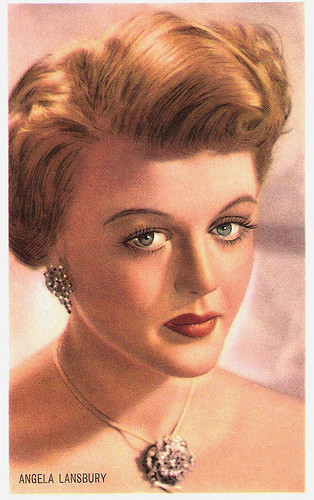
Belgian collectors card by Kwatta, Bois - D'Haine, no. C 238. Photo: Metro-Goldwyn-Mayer. Publicity still for The Red Danube (George Sidney, 1949).
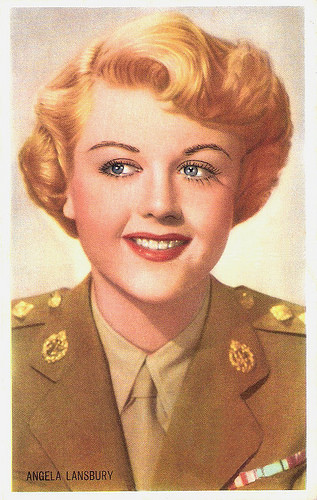
Belgian collectors card by Kwatta, Bois - D'Haine, no. C 280. Photo: Metro-Goldwyn-Mayer. Publicity still for The Red Danube (George Sidney, 1949).
Her greatest success
Angela Lansbury alternated between film, television and the stage for years. In the cinema, Lansbury appeared in 1979 as Miss Froy in The Lady Vanishes (Anthony Page, 1979), a remake of Alfred Hitchcock's famous 1938 film. The following year she appeared in The Mirror Crack'd (Guy Hamilton, 1980), another film based on an Agatha Christie novel, this time as Miss Marple, a sleuth in 1950s Kent. She also played the grandmother in the Gothic fantasy film The Company of Wolves (Neil Jordan, 1984).
That same year, she obtained her greatest success as Jessica Fletcher in the light mystery TV show Murder, She Wrote (1984). For her 12-year stint as the diplomatic, clever and kind fictional writer and sleuth, she became known and loved. From 1985 to 1996, she yearly got Emmy Award nominations for the role without ever winning for it. Eventually she took over production duties for the show as well.
In 2005, she made a notable appearance on Law & Order: Special Victims Unit, which earned her an Emmy Award nomination for Outstanding Guest Actress in a Drama Series. She also voiced several animated characters for films like Beauty and the Beast (Gary Trousdale, Kirk Wise, 1991), in which she voiced Mrs. Potts.
Jim Beaver at IMDb : “An institution in American theatre and television, she is also an inspiration for the graciousness of her personality, which is often exploited and always admired.”
Lansbury was married twice. Her first marriage was to American actor Richard Cromwell. It ended after a year in a divorce. A recent authorized biography, Balancing Act, states that Cromwell was gay, a fact she didn't know until after their separation. Her second husband was British actor Peter Shaw, from 1949 till his death in 2003. Shaw became her manager and launched a production company that would be heavily involved in Murder, She Wrote. The couple had two children, Anthony Pullen Shaw (1952) and Deirdre Angela Shaw (1953).
Angela Lansbury was awarded the CBE (Commander of the Order of the British Empire) in 1994 and the DBE (Dame Commander of Order of the British Empire) in 2014. A year later, she triumphantly returned to London's West End stage after a forty year absence. She starred in her Tony winning role as Madam Arcati in Blithe Spirit. For this role, she won her only Laurence Olivier award for best supporting actress in 2015.
Trailer for Gaslight (George Cukor, 1945). Source: Warner Bros. (YouTube).
Trailer for Something for Everyone (Harold Prince, 1970). Source: Dukece (YouTube).
Trailer The Mirror Crack'd (Guy Hamilton, 1980). Source: Mr80sMovies (YouTube).
Trailer The Company Of Wolves Trailer (Neil Jordan, 1985). Source: Video Detective (YouTube).
Sources: (IMDb), Biography.com, Wikipedia and .

Belgian collectors card by Kwatta, Bois - D'Haine, no. C 301. Photo: Metro-Goldwyn-Mayer. Publicity still for The Three Musketeers (George Sidney, 1948).

Dutch postcard by Takken, no. 166. Photo: Metro-Goldwyn-Mayer.
The Other Woman
Angela Brigid Lansbury was born Regent Park, London in 1925. She was the daughter of actress Moyna MacGill, and timber merchant and politician Edward Lansbury, who died when she was only 9 years old.
Her grandfather, George Lansbury, was the British Labour Party leader in the 1930s. Her younger twin brothers are art director and producer Edgar Lansbury and TV producer Bruce Lansbury, and her older half-sister is Isolde Denham.
Lansbury studied acting from her youth. With her mother and brothers, she departed for the United States in 1940, as the Second World War began. In New York City, Lansbury received a scholarship to study drama at the Lucy Fagan school. She was contracted by MGM while still a teenager.
Lansbury was nominated for an Academy Award for her first film, Gaslight (George Cukor, 1944). Opposite Ingrid Bergman and Charles Boyer , she played the house maid Nancy. Two pictures later, she was again nominated for Best Supporting Actress, this time for playing dance hall lady Sibyl Vane in The Picture of Dorian Gray (Albert Lewin, 1945), based on Oscar Wilde’s story of a man who makes a supernatural pact to remain young at a high cost. She did win a Golden Globe for her supporting role in this film.
Lansbury landed other major roles, including that of Elizabeth Taylor ’s older sister in National Velvet (Clarence Brown, 1944) and opposite Judy Garland in the musical The Harvey Girls (George Sidney, 1946). Now established as a supporting player of quality, she began a long career, often as 'the other woman' in major productions and as the leading lady in lesser films.

Belgian collectors card by Kwatta, Bois - D'Haine, no. C 8. Photo: Metro-Goldwyn-Mayer.

Belgian collectors card by Kwatta, Bois - D'Haine. Photo: Metro-Goldwyn-Mayer.
The manipulating mother
Angela Lansbury became an American citizen in 1951. She appeared as Princess Gwendolyn opposite Danny Kaye in the comedy film The Court Jester (Melvin Frank, 1956), as Minnie Littlejohn in The Long Hot Summer (Martin Ritt, 1958), and as Mabel Claremont in The Reluctant Debutante (Vincente Minelli, 1958).
Her features, while not at all old-appearing, gave her an air of maturity that allowed her to pass as much older than she actually was. She began playing mother roles, often to players of her own age, while yet in her thirties. Lansbury played Elvis Presley's mother in Blue Hawaii (Norman Taurog, 1961), despite only being 10 years older than him.
She was also the manipulating mother of Laurence Harvey in the Cold War thriller The Manchurian Candidate (John Frankenheimer, 1962), while in real life being scarcely three years Harvey's senior. The latter brought her a third Academy Award nomination for supporting actress.
Other film roles included The Amorous Adventures of Moll Flanders (Terence Young, 1965) starring Kim Novak , and the biblical epic The Greatest Story Ever Told (George Stevens, 1965), featuring Max von Sydow as Jesus. In the partially-animated Disney musical Bedknobs and Broomsticks (Robert Stevenson, 1971), she played the witch Miss Price.
However, she concentrated more and more on stage work. She made her Broadway debut in 1957 with the play Hotel Paradiso, a French burlesque set in Paris, directed by Peter Glenville. A role in the drama A Taste of Honey (1961) and the Stephen Sondheim musical Anyone Can Whistle (1964) followed.
She achieved notable success in a number of Broadway musicals. She has been the co-recipient of 4 Grammy Awards for her leading roles in the musicals Mame (1966), Dear World (1969), Gypsy (1975) and Sweeney Todd (1979).
In 2007, she returned to Broadway after more than two decades, performing in the show Deuce. Lansbury played a former tennis pro who reunites with her doubles partner for an honours ceremony at the U.S. Open. Two years later, she won the Tony for Best Featured Actress in a Play for Blithe Spirit, the revival of a Noel Coward play about a man who is haunted by the ghost of his ex-wife. Lansbury continued her stage work, playing Madame Armfeldt in the 2009 revival of Stephen Sondheim's A Little Night Music, opposite Catherine Zeta-Jones, and in 2012 taking on a lead role in the Gore Vidal satire The Best Man.

Belgian collectors card by Kwatta, Bois - D'Haine, no. C 238. Photo: Metro-Goldwyn-Mayer. Publicity still for The Red Danube (George Sidney, 1949).

Belgian collectors card by Kwatta, Bois - D'Haine, no. C 280. Photo: Metro-Goldwyn-Mayer. Publicity still for The Red Danube (George Sidney, 1949).
Her greatest success
Angela Lansbury alternated between film, television and the stage for years. In the cinema, Lansbury appeared in 1979 as Miss Froy in The Lady Vanishes (Anthony Page, 1979), a remake of Alfred Hitchcock's famous 1938 film. The following year she appeared in The Mirror Crack'd (Guy Hamilton, 1980), another film based on an Agatha Christie novel, this time as Miss Marple, a sleuth in 1950s Kent. She also played the grandmother in the Gothic fantasy film The Company of Wolves (Neil Jordan, 1984).
That same year, she obtained her greatest success as Jessica Fletcher in the light mystery TV show Murder, She Wrote (1984). For her 12-year stint as the diplomatic, clever and kind fictional writer and sleuth, she became known and loved. From 1985 to 1996, she yearly got Emmy Award nominations for the role without ever winning for it. Eventually she took over production duties for the show as well.
In 2005, she made a notable appearance on Law & Order: Special Victims Unit, which earned her an Emmy Award nomination for Outstanding Guest Actress in a Drama Series. She also voiced several animated characters for films like Beauty and the Beast (Gary Trousdale, Kirk Wise, 1991), in which she voiced Mrs. Potts.
Jim Beaver at IMDb : “An institution in American theatre and television, she is also an inspiration for the graciousness of her personality, which is often exploited and always admired.”
Lansbury was married twice. Her first marriage was to American actor Richard Cromwell. It ended after a year in a divorce. A recent authorized biography, Balancing Act, states that Cromwell was gay, a fact she didn't know until after their separation. Her second husband was British actor Peter Shaw, from 1949 till his death in 2003. Shaw became her manager and launched a production company that would be heavily involved in Murder, She Wrote. The couple had two children, Anthony Pullen Shaw (1952) and Deirdre Angela Shaw (1953).
Angela Lansbury was awarded the CBE (Commander of the Order of the British Empire) in 1994 and the DBE (Dame Commander of Order of the British Empire) in 2014. A year later, she triumphantly returned to London's West End stage after a forty year absence. She starred in her Tony winning role as Madam Arcati in Blithe Spirit. For this role, she won her only Laurence Olivier award for best supporting actress in 2015.
Trailer for Gaslight (George Cukor, 1945). Source: Warner Bros. (YouTube).
Trailer for Something for Everyone (Harold Prince, 1970). Source: Dukece (YouTube).
Trailer The Mirror Crack'd (Guy Hamilton, 1980). Source: Mr80sMovies (YouTube).
Trailer The Company Of Wolves Trailer (Neil Jordan, 1985). Source: Video Detective (YouTube).
Sources: (IMDb), Biography.com, Wikipedia and .
Published on January 07, 2017 22:00
January 6, 2017
Leslie Banks
Leslie Banks (1890–1952) was an English stage and screen actor, director, and producer. He is now best remembered for playing gruff, menacing characters in black-and-white films of the 1930s and 1940s.
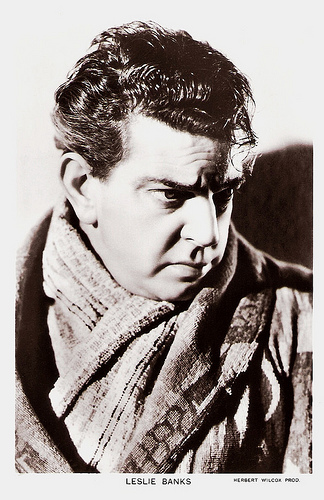
British postcard in the Picturegoer Series, London, no. 919a. Photo: Herbert Wilcox Prod. Publicity still for Three Maxims (Herbert Wilcox, 1936).
A sadistic, diabolical hunter
Leslie James Banks, CBE was born in West Derby, Liverpool, Lancashire, in 1890. His parents were George and Emily (née Dalby) Banks. He attended school at Glenalmond College in Scotland and later studied at Keble College, Oxford with the intention of becoming a parson but decided against this.
Banks joined Frank Benson's company and made his acting debut in 1911 at the town hall, Brechin, playing Old Gobbo in The Merchant of Venice. He then toured the United States and Canada with Henry V. Esmond and Eva Moore in 1912–1913.
Returning to London, he appeared for the first time on the West End, as Lord Murdon in The Dangerous Age in 1914. During the First World War he served with the Essex Regiment. He suffered injuries that left his face partially scarred and paralysed. This later disqualified him from many leading roles that required handsome actors.
In his acting career he would use this injury to good effect by showing the unblemished side of his face when playing comedy or romance and the scarred, paralysed side of his face when playing drama or tragedy. After the war, Banks joined the Birmingham Repertory Theatre. He returned to London in 1921 and established himself as a leading dramatic actor and West End star known for his powerful yet restrained performances.
Working in both London and New York City, he gained prominence on both sides of the Atlantic, and it was when he was in New York that Kenneth Macgowan persuaded him to go to Hollywood. Banks formidable bulk and intimidating face served him well in his first important film role in The Most Dangerous Game (Irving Pichel, Ernest B. Schoedsack, 1932). He played the sadistic Russian Count Zaroff, a diabolical hunter who arranges for a ship to be wrecked on an island where he can unleash his vicious dogs and hunts the passengers in the jungle for sport.
Ralph Michael Stein at IMDb : “Zaroff is, of course, evil but he's also oddly sympathetic. What's a count to do when he can buy anything and only the most extraordinary hunting will bring him happiness? In that light his trophy room becomes understandable, his bloody diversion almost sympathetic. Banks is very effective in this role where he swings between culture and carnage.” The film is based on a 1924 short story of the same name by Richard Connell and also features Joel McCrea and Fay Wray.
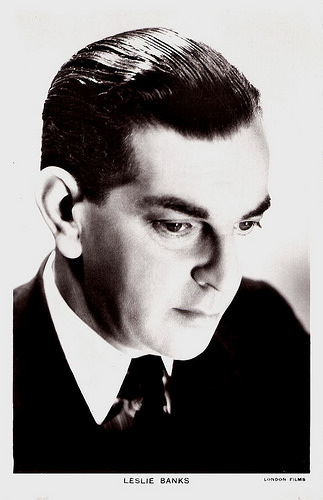
British postcard in the Picturegoer Series, London, no. 818. Photo: London Films.
The Man Who Knew Too Much
For the rest of his career, Leslie Banks divided his time between Britain and the United States and between film and theatre. One of his most successful films was the British thriller The Man Who Knew Too Much (Alfred Hitchcock, 1934) with Edna Best and Peter Lorre .
José Luis Rivera Mendoza at IMDb : “The performances by the actors are of an excellent quality, with Leslie Banks leading the cast with his charming presence and very British wit. His ability to mix drama with comedy makes his character a very real and likable person, that portrays remarkably the everyman placed in an uncommon situation.”
Hitchcock remade the film in 1956 with James Stewart, but the two films are very different in tone, in setting, and in many plot details. Hal Erickon at AllMovie : “the original 1934 version of The Man Who Knew Too Much is arguably a more historically significant and aesthetically interesting film. It was Hitchcock's first true international hit.”
A box office smash was Farewell Again/Troopship (Tim Whelan Sr., 1937), a multi-plotted British comedy-drama about soldiers on leave and the people they've left. Other film with Banks include the historical drama Fire Over England (William K. Howard, 1937) notable for the first pairing of Laurence Olivier and Vivien Leigh , and Hitchcock’s last British film Jamaica Inn (Alfred Hitchcock, 1939) with Charles Laughton and Maureen O’Hara in her first major film role.
Against 'type', Banks starred in British mystery film The Arsenal Stadium Mystery (Thorold Dickinson, 1939), as the eccentric Inspector Anthony Slade. Jim Cross at IMDb : “He plays a curious character who we meet rehearsing policemen in full uniform AND tutus for some sort of theatrical performance! Further, he has a large selection of different hats that he self-consciously picks from every time he has to go and perform some task; when he has to delegate an arrest to his sergeant, he even delegates the appropriate (fishing) hat to him also! Altogether, the character played is fascinating and odd: an English eccentric or a (coded- it is 1939!) gay characterization? Either way, it is Leslie Banks' playing that makes this film at all worth watching...”
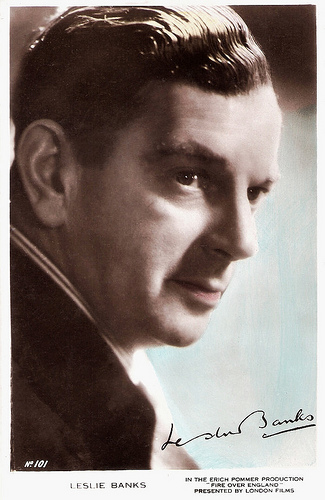
British postcard by Art Photo, no. 101. Photo: London Films / Erich Pommer Production. Publicity still for Fire over England (William K. Howard, 1937).
Fresh and lively - even challenging and daring
Leslie Banks appeared as the Chorus in Henry V (1944), Laurence Olivier 's brilliant Technicolor film adaptation of William Shakespeare's play of the same name.
Bruce Eder at AllMovie : “ Laurence Olivier 's Henry V confounded almost every assumption about bringing Shakespeare's work to the screen. In contrast to previous Shakespeare adaptations, it was fresh and lively -- even challenging and daring -- in its presentation and structure; it had fun with its subject, while other versions had been reverent and respectful; and it delighted audiences, scholars, and critics alike, becoming the first screen adaptation of a Shakespeare play to receive mostly enthusiastic reviews and turn a profit.”
Banks played a supporting part in the thriller The Small Back Room (Michael Powell, Emeric Pressburger, 1949) about the bureaucratic and personal frustrations of a crippled munitions expert (David Farrar) during World War II.
Banks’ final film was Madeleine (David Lean, 1950), based on a true story about Madeleine Smith ( Ann Todd ), a young Glasgow woman from a wealthy family who was tried in 1857 for the murder of her lover, Emile L'Angelier ( Ivan Desn y ). The trial was much publicized in the newspapers of the day and labeled "the trial of the century". Banks played the authoritarian father, unaware of Madeleine's secret life.
His theatre roles included Eliza Comes to Stay (his American debut in 1914), Captain Hook in Peter Pan (his New York debut in 1924), Petruchio in William Shakespeare’s The Taming of the Shrew (1937), the kindly, doddering schoolmaster in the original 1938 staging of Goodbye, Mr Chips (1938), and James Jarvis in the Kurt Weill musical Lost in the Stars (1950).
Leslie Banks married Gwendoline Haldane Unwin in 1915 and the couple had three daughters: Daphne, Virginia, and Evangeline, who became an actress. Banks was appointed a Commander of the Order of the British Empire for his services to theatre in 1950, the year of his last appearances on stage and screen.
Leslie Banks died in 1952, aged 61, from a stroke he suffered while walking.
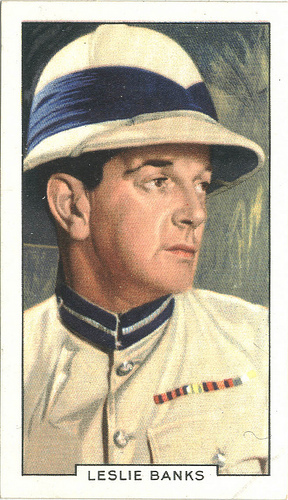
British collector's card by Gallaher in the Portraits of Famous Stars series, no. 10. Collection: Manuel Palomino Arjona (Flickr).
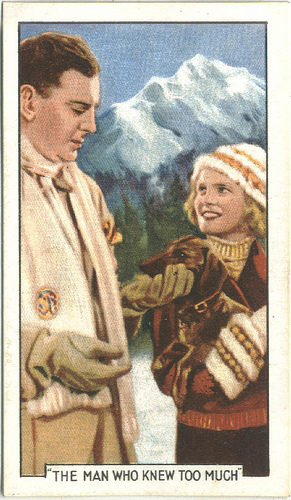
British collectors Card by Gallaher In the Famous Film Scenes, no 41. Leslie Banks and Nora Pilbeam in The Man Who Knew Too Much (Alfred Hitchcock, 1934). Collection: Manuel Palomino Arjona (Flickr).
Sources: Bruce Eder (AllMovie), Hal Erickson (AllMovie), (IMDb), José Luis Rivera Mendoza (IMDb), Jim Cross (IMDb), AllMovie, Wikipedia and .

British postcard in the Picturegoer Series, London, no. 919a. Photo: Herbert Wilcox Prod. Publicity still for Three Maxims (Herbert Wilcox, 1936).
A sadistic, diabolical hunter
Leslie James Banks, CBE was born in West Derby, Liverpool, Lancashire, in 1890. His parents were George and Emily (née Dalby) Banks. He attended school at Glenalmond College in Scotland and later studied at Keble College, Oxford with the intention of becoming a parson but decided against this.
Banks joined Frank Benson's company and made his acting debut in 1911 at the town hall, Brechin, playing Old Gobbo in The Merchant of Venice. He then toured the United States and Canada with Henry V. Esmond and Eva Moore in 1912–1913.
Returning to London, he appeared for the first time on the West End, as Lord Murdon in The Dangerous Age in 1914. During the First World War he served with the Essex Regiment. He suffered injuries that left his face partially scarred and paralysed. This later disqualified him from many leading roles that required handsome actors.
In his acting career he would use this injury to good effect by showing the unblemished side of his face when playing comedy or romance and the scarred, paralysed side of his face when playing drama or tragedy. After the war, Banks joined the Birmingham Repertory Theatre. He returned to London in 1921 and established himself as a leading dramatic actor and West End star known for his powerful yet restrained performances.
Working in both London and New York City, he gained prominence on both sides of the Atlantic, and it was when he was in New York that Kenneth Macgowan persuaded him to go to Hollywood. Banks formidable bulk and intimidating face served him well in his first important film role in The Most Dangerous Game (Irving Pichel, Ernest B. Schoedsack, 1932). He played the sadistic Russian Count Zaroff, a diabolical hunter who arranges for a ship to be wrecked on an island where he can unleash his vicious dogs and hunts the passengers in the jungle for sport.
Ralph Michael Stein at IMDb : “Zaroff is, of course, evil but he's also oddly sympathetic. What's a count to do when he can buy anything and only the most extraordinary hunting will bring him happiness? In that light his trophy room becomes understandable, his bloody diversion almost sympathetic. Banks is very effective in this role where he swings between culture and carnage.” The film is based on a 1924 short story of the same name by Richard Connell and also features Joel McCrea and Fay Wray.

British postcard in the Picturegoer Series, London, no. 818. Photo: London Films.
The Man Who Knew Too Much
For the rest of his career, Leslie Banks divided his time between Britain and the United States and between film and theatre. One of his most successful films was the British thriller The Man Who Knew Too Much (Alfred Hitchcock, 1934) with Edna Best and Peter Lorre .
José Luis Rivera Mendoza at IMDb : “The performances by the actors are of an excellent quality, with Leslie Banks leading the cast with his charming presence and very British wit. His ability to mix drama with comedy makes his character a very real and likable person, that portrays remarkably the everyman placed in an uncommon situation.”
Hitchcock remade the film in 1956 with James Stewart, but the two films are very different in tone, in setting, and in many plot details. Hal Erickon at AllMovie : “the original 1934 version of The Man Who Knew Too Much is arguably a more historically significant and aesthetically interesting film. It was Hitchcock's first true international hit.”
A box office smash was Farewell Again/Troopship (Tim Whelan Sr., 1937), a multi-plotted British comedy-drama about soldiers on leave and the people they've left. Other film with Banks include the historical drama Fire Over England (William K. Howard, 1937) notable for the first pairing of Laurence Olivier and Vivien Leigh , and Hitchcock’s last British film Jamaica Inn (Alfred Hitchcock, 1939) with Charles Laughton and Maureen O’Hara in her first major film role.
Against 'type', Banks starred in British mystery film The Arsenal Stadium Mystery (Thorold Dickinson, 1939), as the eccentric Inspector Anthony Slade. Jim Cross at IMDb : “He plays a curious character who we meet rehearsing policemen in full uniform AND tutus for some sort of theatrical performance! Further, he has a large selection of different hats that he self-consciously picks from every time he has to go and perform some task; when he has to delegate an arrest to his sergeant, he even delegates the appropriate (fishing) hat to him also! Altogether, the character played is fascinating and odd: an English eccentric or a (coded- it is 1939!) gay characterization? Either way, it is Leslie Banks' playing that makes this film at all worth watching...”

British postcard by Art Photo, no. 101. Photo: London Films / Erich Pommer Production. Publicity still for Fire over England (William K. Howard, 1937).
Fresh and lively - even challenging and daring
Leslie Banks appeared as the Chorus in Henry V (1944), Laurence Olivier 's brilliant Technicolor film adaptation of William Shakespeare's play of the same name.
Bruce Eder at AllMovie : “ Laurence Olivier 's Henry V confounded almost every assumption about bringing Shakespeare's work to the screen. In contrast to previous Shakespeare adaptations, it was fresh and lively -- even challenging and daring -- in its presentation and structure; it had fun with its subject, while other versions had been reverent and respectful; and it delighted audiences, scholars, and critics alike, becoming the first screen adaptation of a Shakespeare play to receive mostly enthusiastic reviews and turn a profit.”
Banks played a supporting part in the thriller The Small Back Room (Michael Powell, Emeric Pressburger, 1949) about the bureaucratic and personal frustrations of a crippled munitions expert (David Farrar) during World War II.
Banks’ final film was Madeleine (David Lean, 1950), based on a true story about Madeleine Smith ( Ann Todd ), a young Glasgow woman from a wealthy family who was tried in 1857 for the murder of her lover, Emile L'Angelier ( Ivan Desn y ). The trial was much publicized in the newspapers of the day and labeled "the trial of the century". Banks played the authoritarian father, unaware of Madeleine's secret life.
His theatre roles included Eliza Comes to Stay (his American debut in 1914), Captain Hook in Peter Pan (his New York debut in 1924), Petruchio in William Shakespeare’s The Taming of the Shrew (1937), the kindly, doddering schoolmaster in the original 1938 staging of Goodbye, Mr Chips (1938), and James Jarvis in the Kurt Weill musical Lost in the Stars (1950).
Leslie Banks married Gwendoline Haldane Unwin in 1915 and the couple had three daughters: Daphne, Virginia, and Evangeline, who became an actress. Banks was appointed a Commander of the Order of the British Empire for his services to theatre in 1950, the year of his last appearances on stage and screen.
Leslie Banks died in 1952, aged 61, from a stroke he suffered while walking.

British collector's card by Gallaher in the Portraits of Famous Stars series, no. 10. Collection: Manuel Palomino Arjona (Flickr).

British collectors Card by Gallaher In the Famous Film Scenes, no 41. Leslie Banks and Nora Pilbeam in The Man Who Knew Too Much (Alfred Hitchcock, 1934). Collection: Manuel Palomino Arjona (Flickr).
Sources: Bruce Eder (AllMovie), Hal Erickson (AllMovie), (IMDb), José Luis Rivera Mendoza (IMDb), Jim Cross (IMDb), AllMovie, Wikipedia and .
Published on January 06, 2017 22:00
January 5, 2017
Hertha Thiele
For a brief period during the Weimar Republic, Hertha Thiele (1908-1984) appeared in several controversial stage plays and films. She is best known for playing a 14 year old schoolgirl in love with her female teacher in the ground-breaking Mädchen in Uniform/Girls in Uniform (1931). She received thousands of fan letters - mostly from women. Decades later, Thiele became a well known film and television actress in East Germany.
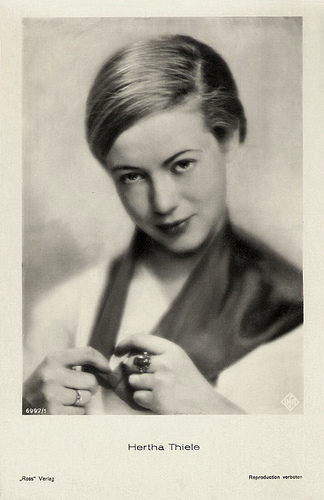
German postcard by Ross Verlag, no. 6997/1, 1931-1932. Photo: Ufa.
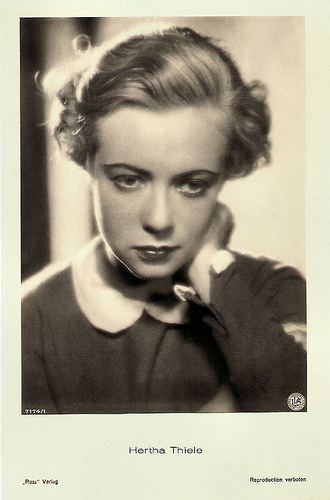
German postcard by Ross Verlag, no. 7174/1, 1932-1933. Photo: Deutsche Lichtspiel-Syndikat (DLS). Publicity still for Das erste Recht des Kindes/The first right of the child (Fritz Wendhausen, 1932).
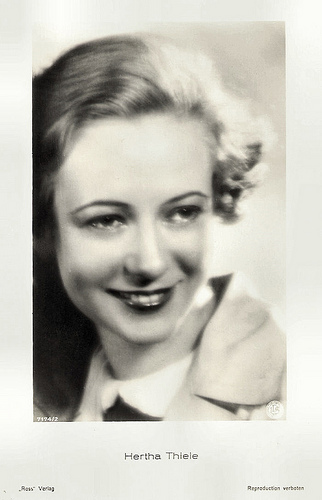
German postcard by Ross Verlag, no. 7174/2, 1932-1933. Photo: Deutsche Lichtspiel-Syndikat (DLS). Publicity still for Das erste Recht des Kindes/The first right of the child (Fritz Wendhausen, 1932).
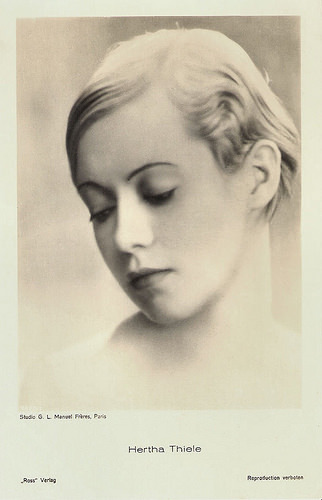
German postcard by Ross Verlag, no. 7423/1, 1932-1933. Photo: G.L. Manuel Frères, Paris.
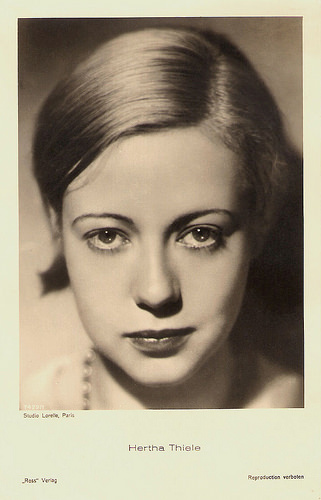
German postcard by Ross Verlag, no. 7423/1, 1932-1933. Studio Lorelle, Paris.
Lesbian-themed Films
Hertha Thiele was born in Leipzig in 1908. Her father worked as a locksmith. She began her acting career on stage at the Schauspielhaus (theatre house) in Leizig with the play Krankheit der Jugend/Disease of Youth by Ferdinand Bruckner in 1928.
Two years later she had her breakthrough there in the original version of Christa Winsloe's play Ritter Nerestan/Knight Nerestan, set in a Prussian boarding school for girls.
She made her film debut in the adaptation, Mädchen in Uniform/Girls in Uniform (Leontine Sagan, Carl Froelich, 1931). Thiele played Manuela, a schoolgirl deeply infatuated with her teacher, played by Dorothea Wieck . The film made her a star and she received thousands of fan letters, mostly from women.
Next Hertha Thiele starred with Ernst Busch in Bertolt Brecht's Kuhle Wampe/To Whom Does the World Belong? (Slatan Dudow, 1932). This interesting film shows the difficult life of a working class family in Berlin in times of the Great Depression. The film was censored in 1932 and banned by the Nazis in 1933, accused of communist tendencies.
Thiele also had a leading role opposite Hermann Thimig and Viktor de Kowa in Kleiner Mann, was nun?/Little Man What Now (Fritz Wendhausen, 1933) based on the novel by Hans Fallada.
She was reunited with Dorothea Wieck in another lesbian-themed film, Anna und Elisabeth/Anna and Elizabeth (Frank Wisbar, 1933). The film was banned by the Nazis soon after it opened. Later, Thiele said that this was the most important work of her career. During the early 1930s, she also continued to play in stage productions by Max Reinhardt (Molnar's Harmonie, 1932) and Veit Harlan (Veronika, 1935).
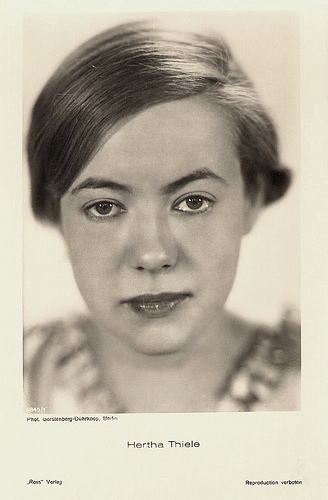
German postcard by Ross Verlag, no. 6845/1, 1931-1932. Photo: Gerstenberg-Dührkoop, Berlin.
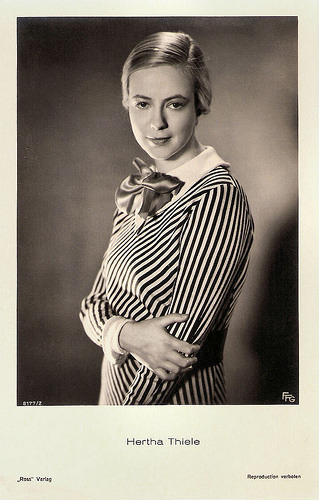
German postcard by Ross Verlag, no. 8117/2, 1933-1934. Photo: FFG (Carl Froelich-Film GmbH). Publicity still for Reifende Jugend/Ripening Youth (Carl Froelich, 1933).
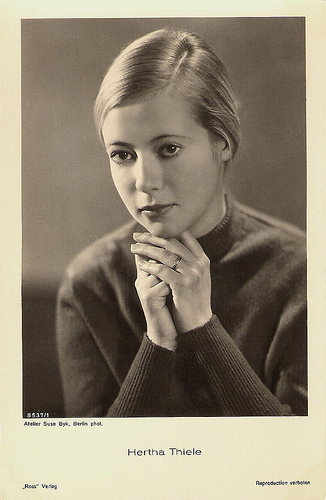
German postcard by Ross Verlag, no. 8537/1, 1933-1934. Photo: Suse Byk, Berlin.
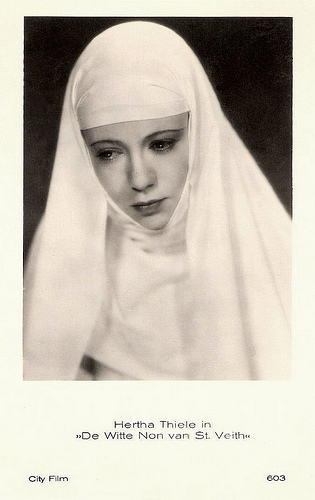
Dutch postcard by City Film, no. 603. Photo: publicity still for Elisabeth und der Narr/Elisabeth, die weisse Schwester von St. Veith (Thea von Harbau, 1934). Hertha Thiele starred as Elisabeth Dietrich.
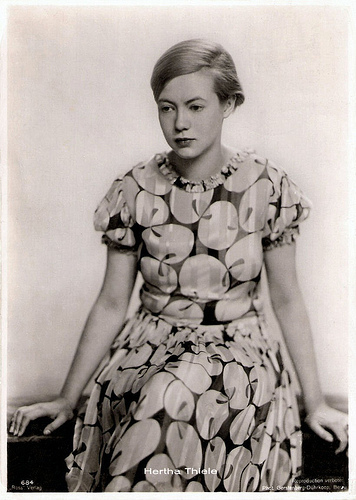
German postcard by Ross Verlag, no. 684. Photo: Gerstenberg-Dührkoop, Berlin.
Not Blowing With The Wind
In 1933 the Nazi government approached Hertha Thiele to appear in the propaganda film Hans Westmar (Franz Wenzler, 1933). She replied to propaganda minister Josef Goebbels: "I don't blow with the wind each time it changes directions." Her film career was thwarted.
In 1932 she had married actor Heinz Klingenberg. She left him when he accepted the title role in the propaganda-film S.A.-Mann Brand/Storm Trooper Brand (Frans Seitz, 1933). They divorced in 1936. That year she was also excluded from the Reichstheater and Reichsfilmkammer.
After this Berufsverbot she left Germany for Switzerland in 1937. It took five years before she was able to find acting work in Bern.
In 1949 Thiele went with her second, Swiss husband to East Germany where she worked for the Berliner Rundfunk. She tried to start a theatre there, but did not succeed. For years she lived in Switzerland and Paris, working as a psychiatric nursing assistant.
In 1966, she finally returned to East Germany. There she worked in stage productions in Magdeburg and Leipzig. During the 1970s she was often seen in TV series and made-for-TV films, including the popular crime series Polizeiruf 110/Police Call 110.
Thiele's work was featured in a television documentary Das Herz auf der linken Seite/The Heart at the Left Side (1975). In 1983 followed a retrospective at the Berlin Film Festival (Exil – Sechs Schauspieler aus Deutschland/Exile - Six Actors from Germany) and a monography on her life and work, which was published by the Deutsche Kinematek.
To her last films belong the DEFA productions Die Legende von Paul und Paula/The Legend of Paul and Paula (Heiner Carow, 1973) starring Angelica Domröse , and Die Unverbesserliche Barbara/The Incorrigible Barbara (Lothar Warneke, 1977) with Dutch actress Cox Habbema .
Hertha Thiele died in 1984 in East-Berlin.
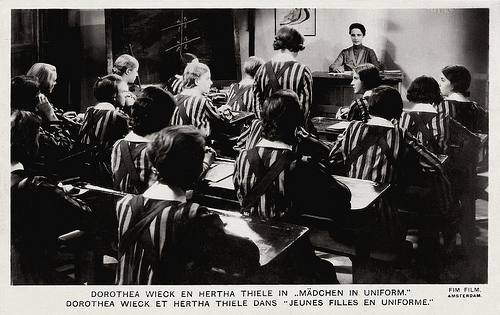
Dutch Postcard by M. Bonnist & Zonen, Amsterdam, Z., no. 104 e. Photo: Fim Film, Amsterdam. Publicity still for Mädchen in Uniform/Girls in Uniform (Leontine Sagan, Carl Froelich, 1931).
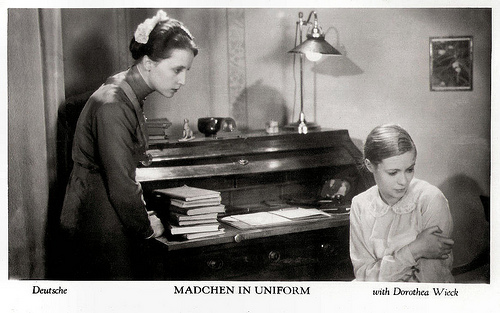
British card in the series Film Shots by Film Weekly. Photo: Deutsche. Publicity still for Mädchen in Uniform/Girls in Uniform (Leontine Sagan, Carl Froelich, 1931) with Dorothea Wieck .
Scene from Mädchen in Uniform/Girls in Uniform (1931). Source: Greek Anon (YouTube).
Scene from Kuhle Wampe/To Whom Does the World Belong? (1932). Source: Kanal von raikomat (YouTube).
Trailer for Die Legende von Paul und Paula (1973). Source: DEFA Stiftung (YouTube).
Sources: Stephanie D'heil (Steffi-line - German), Thomas Staedeli (Cyranos), Filmportal.de (German), Wikipedia, and .

German postcard by Ross Verlag, no. 6997/1, 1931-1932. Photo: Ufa.

German postcard by Ross Verlag, no. 7174/1, 1932-1933. Photo: Deutsche Lichtspiel-Syndikat (DLS). Publicity still for Das erste Recht des Kindes/The first right of the child (Fritz Wendhausen, 1932).

German postcard by Ross Verlag, no. 7174/2, 1932-1933. Photo: Deutsche Lichtspiel-Syndikat (DLS). Publicity still for Das erste Recht des Kindes/The first right of the child (Fritz Wendhausen, 1932).

German postcard by Ross Verlag, no. 7423/1, 1932-1933. Photo: G.L. Manuel Frères, Paris.

German postcard by Ross Verlag, no. 7423/1, 1932-1933. Studio Lorelle, Paris.
Lesbian-themed Films
Hertha Thiele was born in Leipzig in 1908. Her father worked as a locksmith. She began her acting career on stage at the Schauspielhaus (theatre house) in Leizig with the play Krankheit der Jugend/Disease of Youth by Ferdinand Bruckner in 1928.
Two years later she had her breakthrough there in the original version of Christa Winsloe's play Ritter Nerestan/Knight Nerestan, set in a Prussian boarding school for girls.
She made her film debut in the adaptation, Mädchen in Uniform/Girls in Uniform (Leontine Sagan, Carl Froelich, 1931). Thiele played Manuela, a schoolgirl deeply infatuated with her teacher, played by Dorothea Wieck . The film made her a star and she received thousands of fan letters, mostly from women.
Next Hertha Thiele starred with Ernst Busch in Bertolt Brecht's Kuhle Wampe/To Whom Does the World Belong? (Slatan Dudow, 1932). This interesting film shows the difficult life of a working class family in Berlin in times of the Great Depression. The film was censored in 1932 and banned by the Nazis in 1933, accused of communist tendencies.
Thiele also had a leading role opposite Hermann Thimig and Viktor de Kowa in Kleiner Mann, was nun?/Little Man What Now (Fritz Wendhausen, 1933) based on the novel by Hans Fallada.
She was reunited with Dorothea Wieck in another lesbian-themed film, Anna und Elisabeth/Anna and Elizabeth (Frank Wisbar, 1933). The film was banned by the Nazis soon after it opened. Later, Thiele said that this was the most important work of her career. During the early 1930s, she also continued to play in stage productions by Max Reinhardt (Molnar's Harmonie, 1932) and Veit Harlan (Veronika, 1935).

German postcard by Ross Verlag, no. 6845/1, 1931-1932. Photo: Gerstenberg-Dührkoop, Berlin.

German postcard by Ross Verlag, no. 8117/2, 1933-1934. Photo: FFG (Carl Froelich-Film GmbH). Publicity still for Reifende Jugend/Ripening Youth (Carl Froelich, 1933).

German postcard by Ross Verlag, no. 8537/1, 1933-1934. Photo: Suse Byk, Berlin.

Dutch postcard by City Film, no. 603. Photo: publicity still for Elisabeth und der Narr/Elisabeth, die weisse Schwester von St. Veith (Thea von Harbau, 1934). Hertha Thiele starred as Elisabeth Dietrich.

German postcard by Ross Verlag, no. 684. Photo: Gerstenberg-Dührkoop, Berlin.
Not Blowing With The Wind
In 1933 the Nazi government approached Hertha Thiele to appear in the propaganda film Hans Westmar (Franz Wenzler, 1933). She replied to propaganda minister Josef Goebbels: "I don't blow with the wind each time it changes directions." Her film career was thwarted.
In 1932 she had married actor Heinz Klingenberg. She left him when he accepted the title role in the propaganda-film S.A.-Mann Brand/Storm Trooper Brand (Frans Seitz, 1933). They divorced in 1936. That year she was also excluded from the Reichstheater and Reichsfilmkammer.
After this Berufsverbot she left Germany for Switzerland in 1937. It took five years before she was able to find acting work in Bern.
In 1949 Thiele went with her second, Swiss husband to East Germany where she worked for the Berliner Rundfunk. She tried to start a theatre there, but did not succeed. For years she lived in Switzerland and Paris, working as a psychiatric nursing assistant.
In 1966, she finally returned to East Germany. There she worked in stage productions in Magdeburg and Leipzig. During the 1970s she was often seen in TV series and made-for-TV films, including the popular crime series Polizeiruf 110/Police Call 110.
Thiele's work was featured in a television documentary Das Herz auf der linken Seite/The Heart at the Left Side (1975). In 1983 followed a retrospective at the Berlin Film Festival (Exil – Sechs Schauspieler aus Deutschland/Exile - Six Actors from Germany) and a monography on her life and work, which was published by the Deutsche Kinematek.
To her last films belong the DEFA productions Die Legende von Paul und Paula/The Legend of Paul and Paula (Heiner Carow, 1973) starring Angelica Domröse , and Die Unverbesserliche Barbara/The Incorrigible Barbara (Lothar Warneke, 1977) with Dutch actress Cox Habbema .
Hertha Thiele died in 1984 in East-Berlin.

Dutch Postcard by M. Bonnist & Zonen, Amsterdam, Z., no. 104 e. Photo: Fim Film, Amsterdam. Publicity still for Mädchen in Uniform/Girls in Uniform (Leontine Sagan, Carl Froelich, 1931).

British card in the series Film Shots by Film Weekly. Photo: Deutsche. Publicity still for Mädchen in Uniform/Girls in Uniform (Leontine Sagan, Carl Froelich, 1931) with Dorothea Wieck .
Scene from Mädchen in Uniform/Girls in Uniform (1931). Source: Greek Anon (YouTube).
Scene from Kuhle Wampe/To Whom Does the World Belong? (1932). Source: Kanal von raikomat (YouTube).
Trailer for Die Legende von Paul und Paula (1973). Source: DEFA Stiftung (YouTube).
Sources: Stephanie D'heil (Steffi-line - German), Thomas Staedeli (Cyranos), Filmportal.de (German), Wikipedia, and .
Published on January 05, 2017 22:00
January 4, 2017
Milena Dvorská
Czech actress Milena Dvorská (1938-2009) appeared in 70 films and television shows between 1955 and 2009. Dvorská could be seen in many Czech historical films and in fairy tale films.
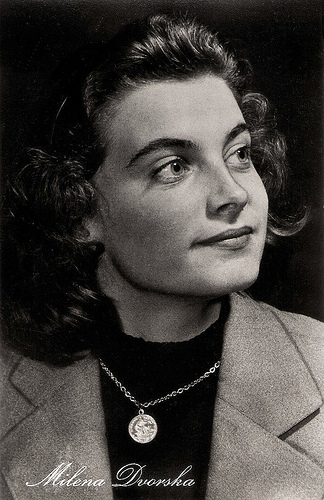
East-German postcard by VEB Progress Film-Vertrieb, Berlin, no. 283, 1957. Photo: Gerhard Kindt.
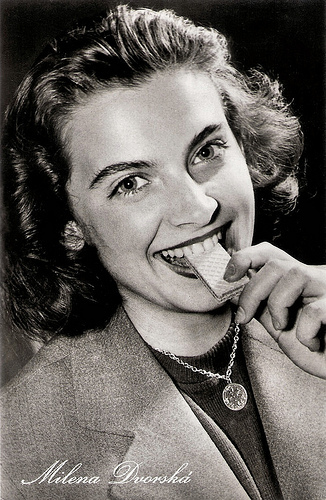
East-German postcard by VEB Progress Film-Vertrieb, Berlin, no. 855, 1958. Photo: Gerhard Pullmann.
There was once a Princess
Milena Dvorská was born in 1938 in Prostejov, Czechoslovakia (now Czech Republic). As a teenager, she worked as a nurse.
She had no drama training, but still she was discovered for the cinema. Her film debut was as Princess Maruška in the fairy tale Byl jednou jeden kraal/There was once a King (Bořivoj Zeman, 1955). The same year she made Anděl na horách/Angel in the Mountains (Borivoj Zeman, 1955).
After these parts, she had a professional drama training at the DAMU - Divadelní fakulta Akademie múzických umění (the Theatre Faculty of the Academy of Performing Arts) in Prague.
After graduating in 1961, her adult film career started with films like Poslední růže od Casanovy/The last roses from Casanova (Václav Krška, 1966) in which she played the young Countess Valerie Valdstejns, and the comedy Nejlepší ženská mého života/The Best Woman in My Life (1968), the final film of director Martin Fric.
She would appear in more than 60 very diverse Czechoslovakian film productions. In 1961, she also became a member of the company of the Prague theatre D 47, led by Emil František Burian. Till 1991, she appeared there in numerous roles.
Between 1970 and 1972, she played in Prague at the Krejčovým Divadlem za branou, a theatre founded by Otomar Krejča. After she left the theatre in 1991, she worked for a while for the office of President Vaclav Havel.
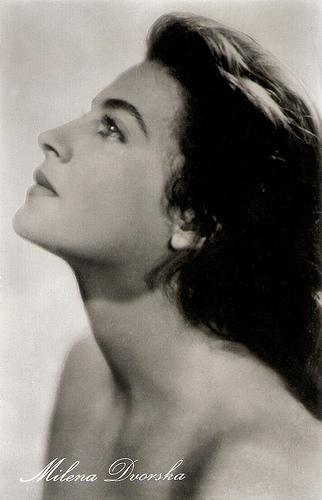
East-German postcard by VEB Progress Film-Vertrieb, Berlin, no. 1042, 1959.
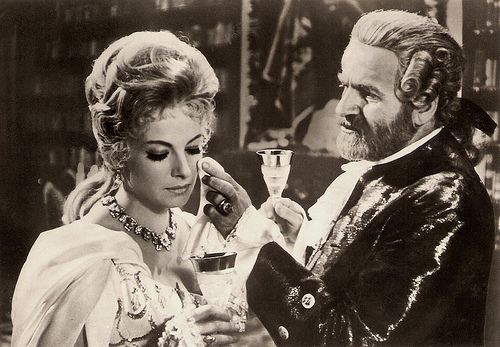
East-German postcard by VEB Progress Film-Vertrieb, Berlin, no. 2688, 1965. Photo: publicity still for Poslední ruze od Casanovy/Last Rose from Casanova (Václav Krska, 1966) with Felix Le Breux as Casanova.
Cult following
In addition to her film appearances Milena Dvorská also took roles in television films and television series. She acted in an episode of the well-known Czech television series Pan Tau (Jindrich Polák, 1970). In 1973 Dvorská played in the East-German-Czech coproduction Die Elixiere des Teufels/The Devil’s Elixir (Brigitte Karsten, Ralf Kirsten, 1973), an adaptation of the novel by E. T. A. Hoffmann.
In 1975 she played the role of the queen in the mini-series Des Christoffel von Grimmelshausen abenteuerlicher Simplizissimus/The adventurer Simplicissimus (Fritz Umgelter, 1975) alongside Matthias Habich. Opposite Libuše Šafránková, she played the wicked witch in the fairytale film Malá mořská víla/The Little Mermaid (Karel Kachyňa, 1977), based on the tale by Hans Christian Andersen.
Another classic fairy tale film is Jak se budí princezny/How to awake Sleeping Beauty with a kiss (Václav Vorlíček, 1977), in which she played the queen and the mother of Marie Horáková.
In the cinema, she had supporting parts in such Czech productions as the drama Běž, ať ti neuteče/Do Be Quick (Stanislav Strnad, 1977), the comedy Jára Cimrman ležící, spící/Jára Cimrman Lying, Sleeping (Ladislav Smoljak, 1983), about the fictional national hero Jára Cimrman, and the drama Noc smaragdového měsíce/The Night of the Emerald Moon (Václav Matějka, 1985).
That year, she was also in the melancholy comedy Vesničko má středisková/My Sweet Little Village (Jiří Menzel, 1985) which was nominated for the Oscar for Best foreign language film. In the Czech Republic and Slovakia the film retains a cult following. In a film version of the opera Libuše by Smetana she embodied in an impressive manner the title role.
Among her last films were another adaptation of the Sleeping Beauty fairy tale, Šípková Růženka (Stanislav Párnický, 1990) and the bitter comedic-drama Kamenný most/the Stone Bridge (Tomás Vorel, 1996). She also worked as a voice actor. In 1997 she was nominated for the Czech film award Český lev. In 2006, she published her memoir Vyprávění o životě (Talking about life).
Milena Dvorská died on in 2009 in Prague, the capital of the Czech Republic. She was 71. Her husband was Josefa Krause and they had a daughter, Lucii, and a son, Jakuba.
Scene from Poslední růže od Casanovy/The last roses from Casanova (1966) with Felix le Breux and Milena Dvorská. Source: geislerrgmail (YouTube). Sorry, no subtitles!
Czech trailer for Kamenný most/the Stone Bridge (1996). Source: VOREL FILM official channel (YouTube). Sorry, no subtitles!
Sources: Jaroslav ‘Krib’ Lopour (CSFD – Czech), Wikipedia (German and English), and .

East-German postcard by VEB Progress Film-Vertrieb, Berlin, no. 283, 1957. Photo: Gerhard Kindt.

East-German postcard by VEB Progress Film-Vertrieb, Berlin, no. 855, 1958. Photo: Gerhard Pullmann.
There was once a Princess
Milena Dvorská was born in 1938 in Prostejov, Czechoslovakia (now Czech Republic). As a teenager, she worked as a nurse.
She had no drama training, but still she was discovered for the cinema. Her film debut was as Princess Maruška in the fairy tale Byl jednou jeden kraal/There was once a King (Bořivoj Zeman, 1955). The same year she made Anděl na horách/Angel in the Mountains (Borivoj Zeman, 1955).
After these parts, she had a professional drama training at the DAMU - Divadelní fakulta Akademie múzických umění (the Theatre Faculty of the Academy of Performing Arts) in Prague.
After graduating in 1961, her adult film career started with films like Poslední růže od Casanovy/The last roses from Casanova (Václav Krška, 1966) in which she played the young Countess Valerie Valdstejns, and the comedy Nejlepší ženská mého života/The Best Woman in My Life (1968), the final film of director Martin Fric.
She would appear in more than 60 very diverse Czechoslovakian film productions. In 1961, she also became a member of the company of the Prague theatre D 47, led by Emil František Burian. Till 1991, she appeared there in numerous roles.
Between 1970 and 1972, she played in Prague at the Krejčovým Divadlem za branou, a theatre founded by Otomar Krejča. After she left the theatre in 1991, she worked for a while for the office of President Vaclav Havel.

East-German postcard by VEB Progress Film-Vertrieb, Berlin, no. 1042, 1959.

East-German postcard by VEB Progress Film-Vertrieb, Berlin, no. 2688, 1965. Photo: publicity still for Poslední ruze od Casanovy/Last Rose from Casanova (Václav Krska, 1966) with Felix Le Breux as Casanova.
Cult following
In addition to her film appearances Milena Dvorská also took roles in television films and television series. She acted in an episode of the well-known Czech television series Pan Tau (Jindrich Polák, 1970). In 1973 Dvorská played in the East-German-Czech coproduction Die Elixiere des Teufels/The Devil’s Elixir (Brigitte Karsten, Ralf Kirsten, 1973), an adaptation of the novel by E. T. A. Hoffmann.
In 1975 she played the role of the queen in the mini-series Des Christoffel von Grimmelshausen abenteuerlicher Simplizissimus/The adventurer Simplicissimus (Fritz Umgelter, 1975) alongside Matthias Habich. Opposite Libuše Šafránková, she played the wicked witch in the fairytale film Malá mořská víla/The Little Mermaid (Karel Kachyňa, 1977), based on the tale by Hans Christian Andersen.
Another classic fairy tale film is Jak se budí princezny/How to awake Sleeping Beauty with a kiss (Václav Vorlíček, 1977), in which she played the queen and the mother of Marie Horáková.
In the cinema, she had supporting parts in such Czech productions as the drama Běž, ať ti neuteče/Do Be Quick (Stanislav Strnad, 1977), the comedy Jára Cimrman ležící, spící/Jára Cimrman Lying, Sleeping (Ladislav Smoljak, 1983), about the fictional national hero Jára Cimrman, and the drama Noc smaragdového měsíce/The Night of the Emerald Moon (Václav Matějka, 1985).
That year, she was also in the melancholy comedy Vesničko má středisková/My Sweet Little Village (Jiří Menzel, 1985) which was nominated for the Oscar for Best foreign language film. In the Czech Republic and Slovakia the film retains a cult following. In a film version of the opera Libuše by Smetana she embodied in an impressive manner the title role.
Among her last films were another adaptation of the Sleeping Beauty fairy tale, Šípková Růženka (Stanislav Párnický, 1990) and the bitter comedic-drama Kamenný most/the Stone Bridge (Tomás Vorel, 1996). She also worked as a voice actor. In 1997 she was nominated for the Czech film award Český lev. In 2006, she published her memoir Vyprávění o životě (Talking about life).
Milena Dvorská died on in 2009 in Prague, the capital of the Czech Republic. She was 71. Her husband was Josefa Krause and they had a daughter, Lucii, and a son, Jakuba.
Scene from Poslední růže od Casanovy/The last roses from Casanova (1966) with Felix le Breux and Milena Dvorská. Source: geislerrgmail (YouTube). Sorry, no subtitles!
Czech trailer for Kamenný most/the Stone Bridge (1996). Source: VOREL FILM official channel (YouTube). Sorry, no subtitles!
Sources: Jaroslav ‘Krib’ Lopour (CSFD – Czech), Wikipedia (German and English), and .
Published on January 04, 2017 22:00
Paul van Yperen's Blog
- Paul van Yperen's profile
- 13 followers
Paul van Yperen isn't a Goodreads Author
(yet),
but they
do have a blog,
so here are some recent posts imported from
their feed.



